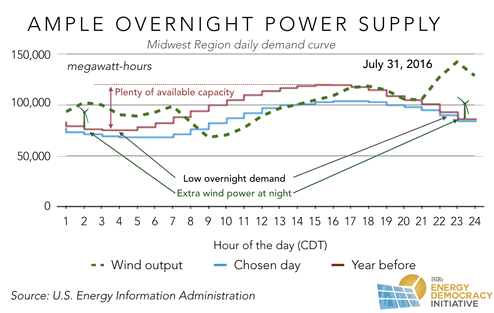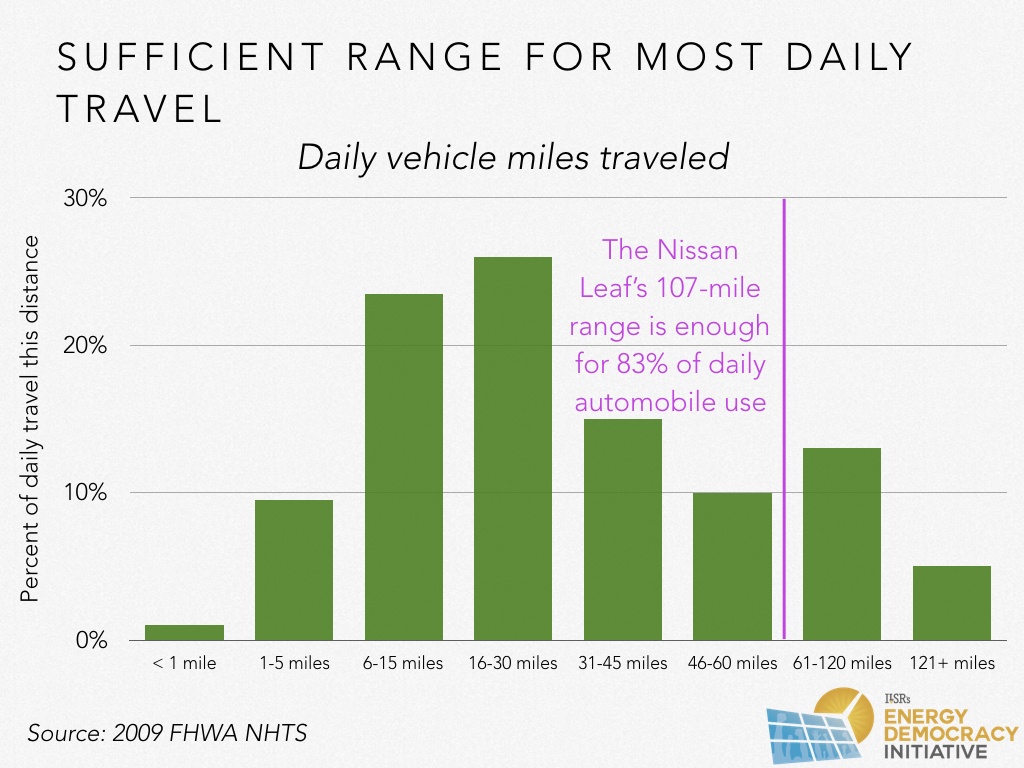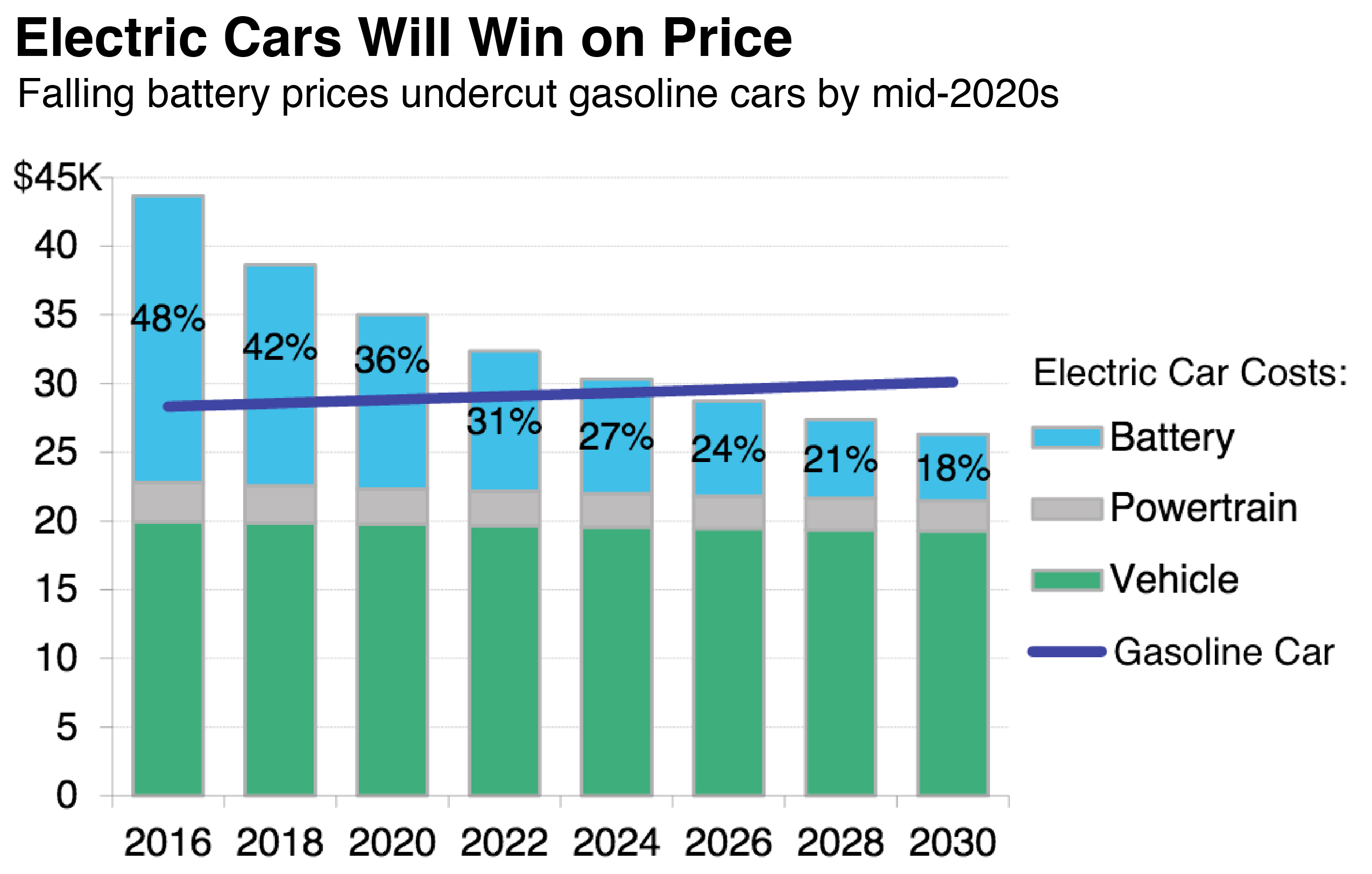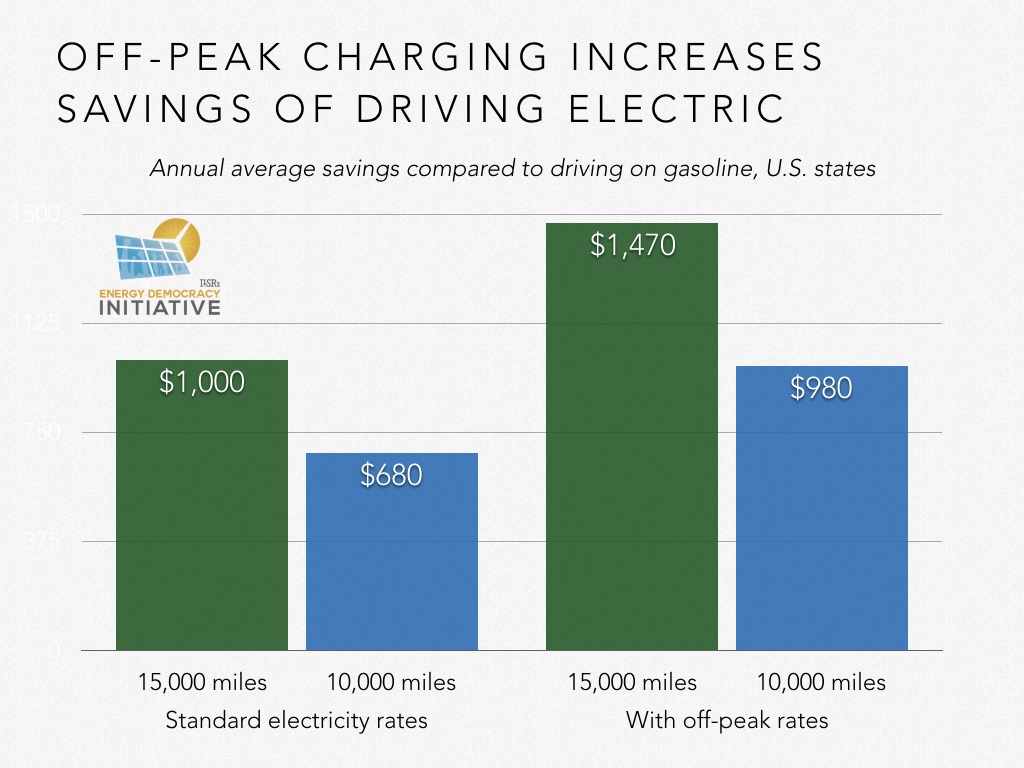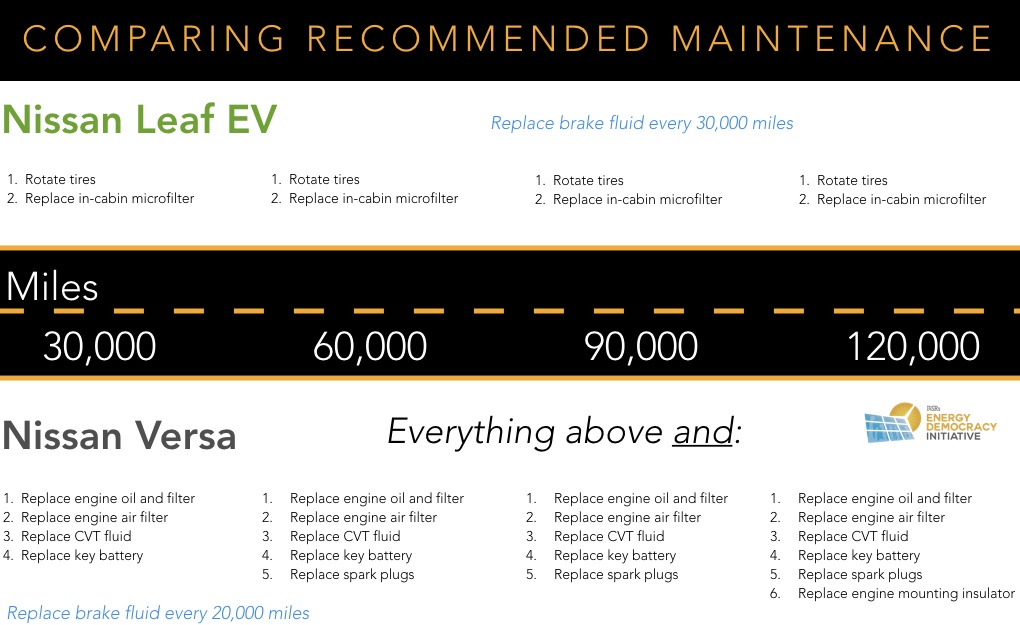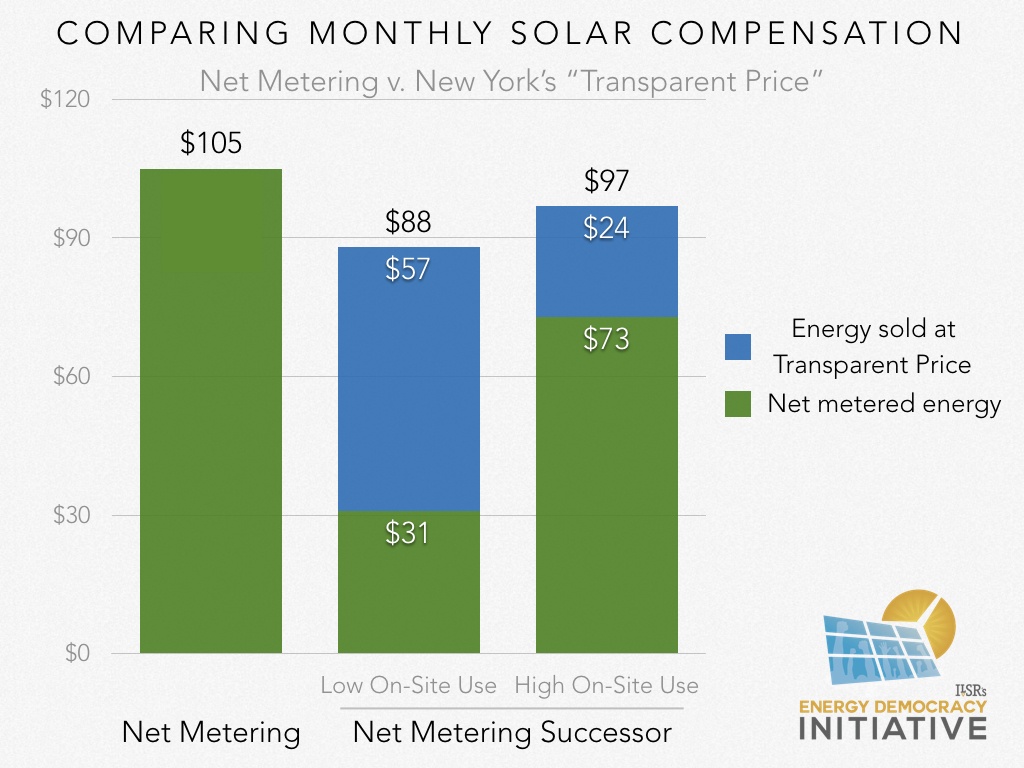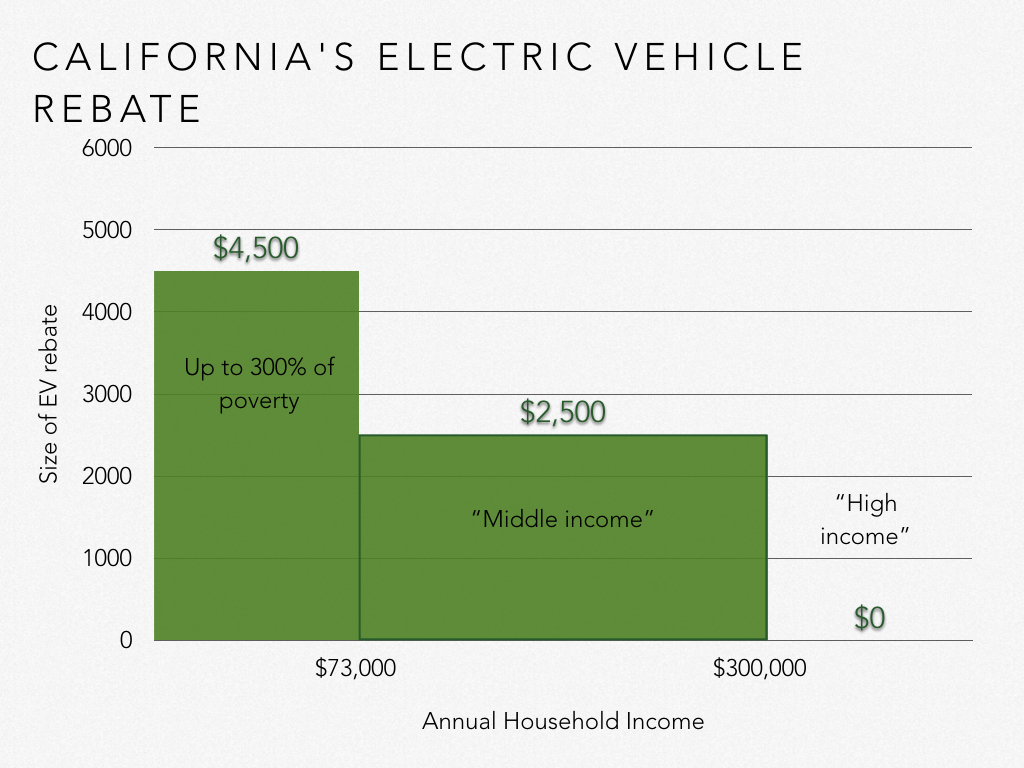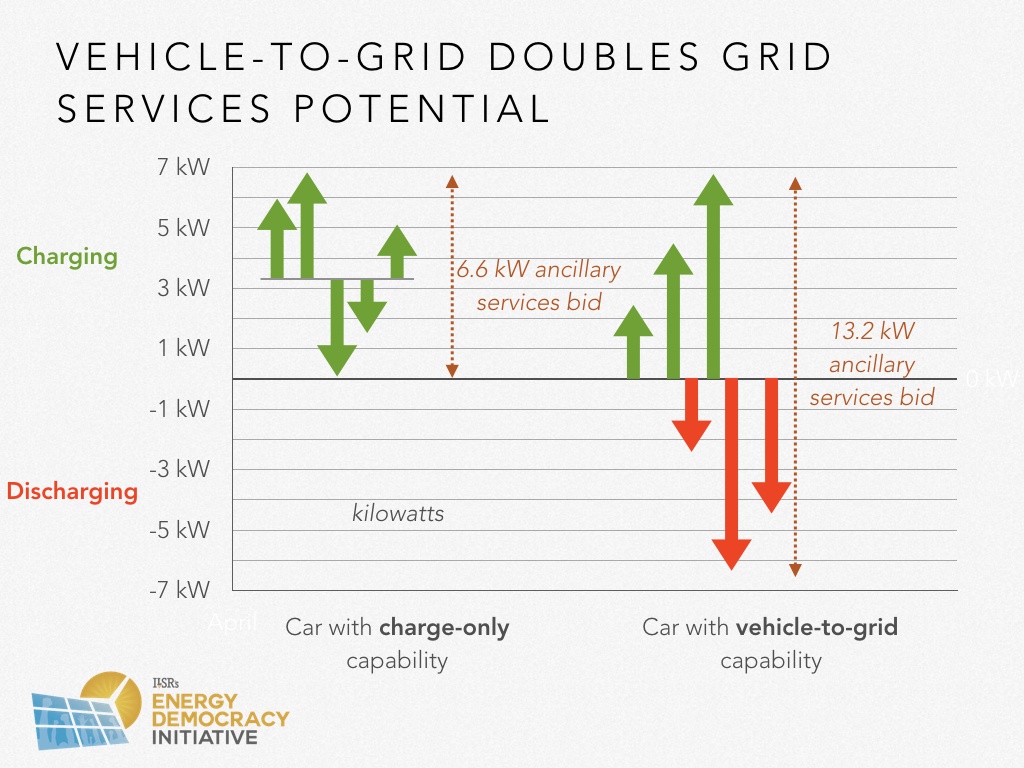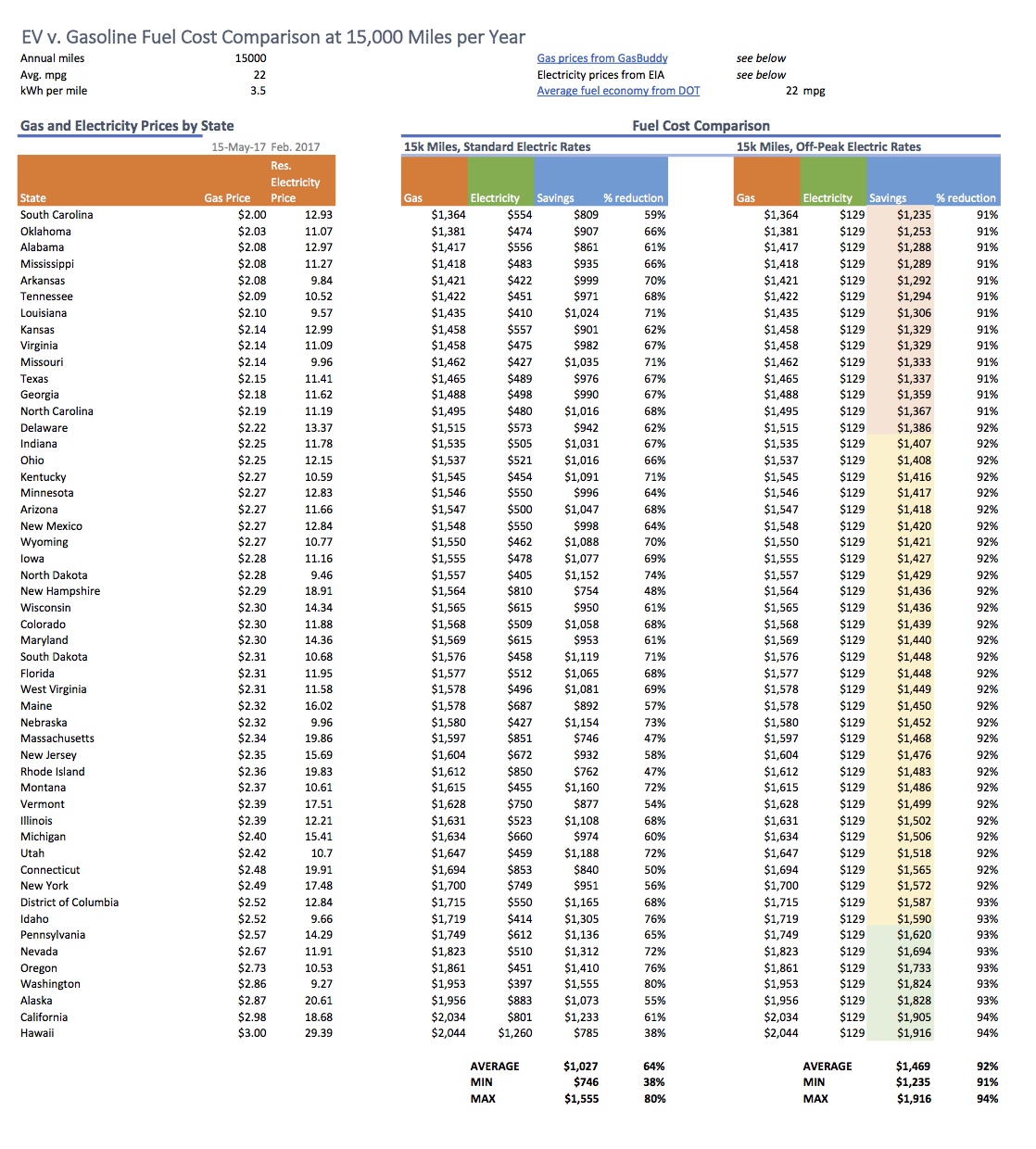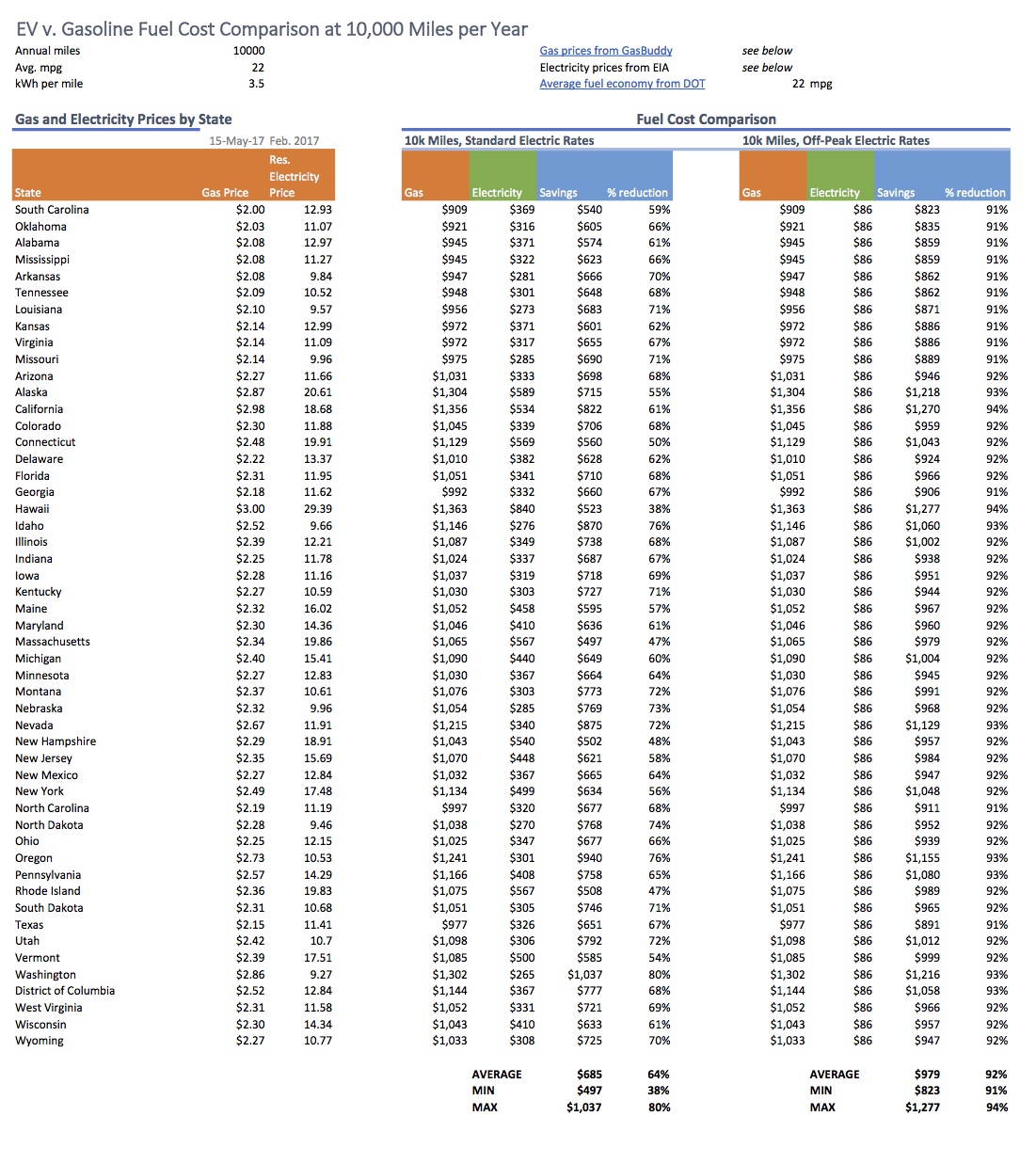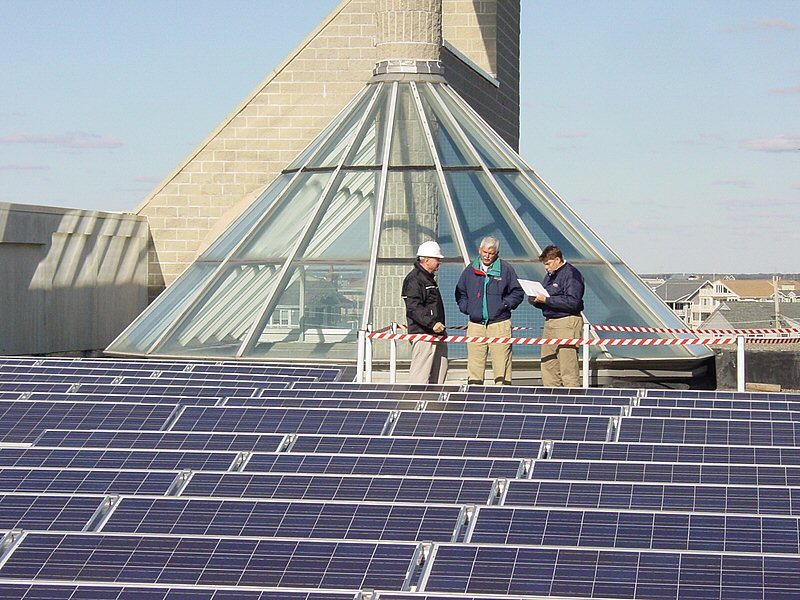Key Links:
Download: Executive Summary
Download: Full Report
View: video and slides from the webinar
Listen: a series of paired podcast episodes about electric vehicles…
Executive Summary
The U.S. vehicle market will undergo a massive technology disruption from electric vehicles in the coming decades. Many analysts see the potential for surging sales of these efficient vehicles to enable smart grid management, but few have explored the local impact of electric vehicles: promoting energy democracy. Electric vehicles offer a natural use for solar energy, a pathway to pump more local solar power onto the grid, and a source of resilient power when the grid goes down. Ultimately, electric vehicles are another tool to miniaturize the electricity system, providing unprecedented local control.
The imminent transformation requires immediate attention to policy and planning. Electric utilities typically produce 15-year or longer “resource plans” to map out additions of new power plants and power lines that will last for decades. But electric vehicles may have an impact much sooner than the 40-year lifetime of these traditional resources, or even the 15-year timeframe of resources plans. The rising numbers of electric cars on U.S. roads may impact utility plans well within their current planning horizon. The time for action is now.
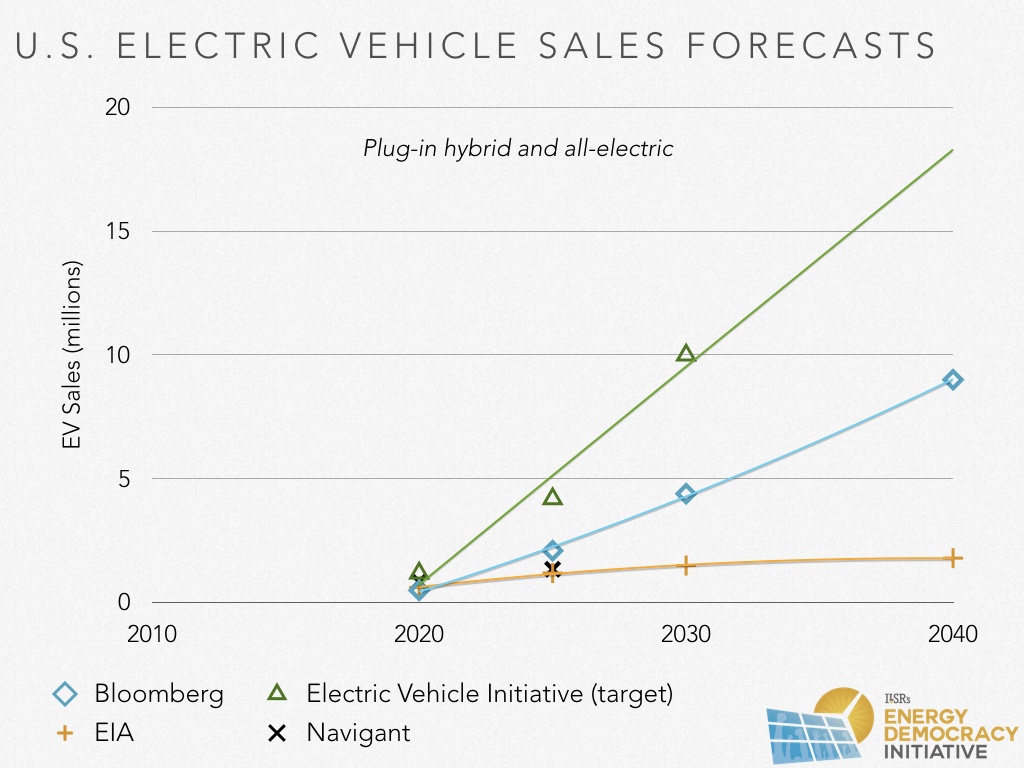 Surging Electric Vehicle Sales
Surging Electric Vehicle Sales
With sales rising rapidly as range expands and costs fall, many forecasters expect significant deployment of electric vehicles by 2040. Electric grid managers will have to account for the impact of transportation electrification and accommodate a wide range of vehicle adoption forecasts.
Prospective car buyers will also consider the long-term opportunity, as the total cost of electric vehicle ownership becomes comparable to gas-powered cars. Already, avoided scheduled maintenance and fuel costs are likely to save electric car drivers as much as $10,000 compared with owning a comparable internal combustion vehicle.
 Making the Grid More Efficient
Making the Grid More Efficient
As a large new source of electricity demand, electric vehicles can cut transportation-related pollution and give grid managers unprecedented ability to make the electricity system more efficient.
Timed charging of electric vehicles means afternoon surges in electricity demand can be smoothed out (shown right) by steadily increasing demand from electric cars.
Additionally, electric cars can soak up excess energy supply by charging overnight to absorb surplus wind energy, as shown in the following chart from the Midwest Independent System Operator.
 Finally, electric cars can support the basic balancing act of the grid by adjusting their charging levels second-to-second in order to maintain a steady voltage and frequency (a practice called “ancillary services”). Taking advantage of this power will require new market rules, but vehicles with nothing more than a Level 2 charger could provide valuable services to the grid, often able to respond more quickly than than existing power sources.
Finally, electric cars can support the basic balancing act of the grid by adjusting their charging levels second-to-second in order to maintain a steady voltage and frequency (a practice called “ancillary services”). Taking advantage of this power will require new market rules, but vehicles with nothing more than a Level 2 charger could provide valuable services to the grid, often able to respond more quickly than than existing power sources.
Enabling Energy Democracy
Electric vehicles can crucially expand the opportunity and capacity for local energy production and resiliency. Like solar, electric cars are a conspicuous way to burnish an owner’s environmental or self-reliance bona fides and to save money. But the combination of the “sexy electrics” — solar and electric cars — is also a marriage of complementary technologies, an increasingly inexpensive power source and a flexible power user. Individuals can fuel their vehicle using sun from their rooftop. Communities can generate more solar locally by putting more of that power to use at home, to power vehicles. The following graphic illustrates how electric vehicles could absorb daytime solar energy, enabling more homes and businesses to go solar without requiring grid upgrades.
Finally, electric vehicles can provide resilient power to communities under threat of severe weather or natural disasters, since today’s electric vehicles already have enough battery power to run an average American home for 24 hours.
Getting the Right Rules
The power of electric cars won’t flow automatically, but instead requires the proper rules to expand and refine charging infrastructure, charging policies and prices to incentivize grid-friendly behavior, and incentives for access that ensure all Americans (car owners or not) can benefit from transportation electrification. ILSR’s recommendations are below:
Infrastructure
- Utilities should finance private chargers and invest in public charging networks based on future revenue from sales of electricity to power vehicles (and/or implement inclusive, tariff-based on-bill financing). Regulators should ensure choice and competition in charging hardware for private and public chargers.
- Public charging infrastructure should be well distributed geographically and equitably, especially in areas where private parking and charging is less available, such as near multi-family housing and business districts.
- Cities should allow residents and businesses to use Property Assessed Clean Energy (PACE) financing for electric vehicle charging hardware, and also lead by example by electrifying fleet vehicles and providing public access to fleet charging stations.
Charging
- Utilities should offer charging plans that include substantial discounts for charging during off-peak hours or absorbing excess renewable energy supply.
- Utilities should lower barriers (such as hardware and installation costs) to accessing discounted charging programs.
- Utilities, charger manufacturers, and automakers should harmonize technology to allow for vehicle charging to follow and accommodate renewable energy supply.
- Cities should work with utilities and car dealers to offer bundled solar and electric vehicle purchases, and deploy policies to support on-site charging from solar.
Incentives and Access
- Electric vehicle incentives should be means-tested.
- Car-sharing and transit systems should be electrified due to widespread health and environmental benefits.
Introduction
Electric cars aren’t new.
At the dawn of the U.S. auto industry in the late 1800s, electric vehicles outsold all other types of cars. By 1900, electric autos accounted for one-third of all vehicles on U.S. roadways. Of the 4,192 vehicles produced in the U.S. and tallied in the 1900 census, 1,575 were electric.
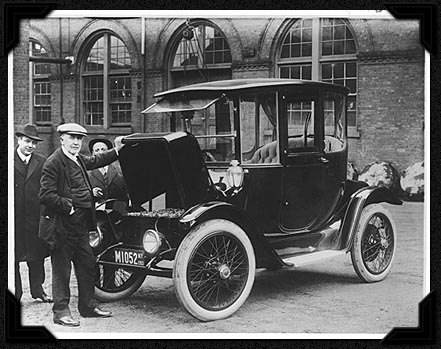 Electric vehicles sales remained strong in the following decade and provided a launchpad for fledgling automakers, including Oldsmobile and Porsche, that would go on to become industry titans. Even Henry Ford partnered with Thomas Edison to explore electric vehicle technology. Battery-powered models, considered fast and reliable, sparked a major transportation renaissance.
Electric vehicles sales remained strong in the following decade and provided a launchpad for fledgling automakers, including Oldsmobile and Porsche, that would go on to become industry titans. Even Henry Ford partnered with Thomas Edison to explore electric vehicle technology. Battery-powered models, considered fast and reliable, sparked a major transportation renaissance.
But the momentum shifted over the first few decades of the 20th century, as the electric starter supplanted hand-cranking to start gas engines. The prices of those models dropped. A network of inter-city roadways enabled drivers to travel farther — more easily done in those days in gas-powered vehicles — and the discovery of domestic crude oil made gasoline cheaper.
The internal combustion engine gained a superiority that would persist for decades.
Nearly 100 years later, a second wave of electric vehicles arrived, driven by California’s zero-emissions vehicle policy in the late 1990s. Unfortunately, it faltered. The enthusiasm of electric vehicle owners couldn’t overcome the reluctance of cash-flush automakers to invest in alternatives to gas-powered vehicles. Automakers also mounted successful lobbying efforts to weaken the zero-emissions vehicle policy. In 1999, General Motors ended production of its own promising electric vehicle, the EV1, after just three years. The automaker removed all 1,100 models from the roads, despite outcry from their drivers. It blamed its pivot away from electric vehicle technology on the EV1’s 100-mile range and the high cost of development compared to sales. Oil giants, still powerful political lobbies, also opposed electric vehicle innovation.
However, the undermining of all-electric cars laid the groundwork for today’s innovation. Hybrid electric cars like the Honda Insight and Toyota Prius — with a small battery-powered electric motor assisting the gasoline engine — became the preferred answer to California’s modified low-emission program, and sales grew steadily. Other hybrid models followed.
Now, nearly two decades later and 120 years after its introduction, the electric car is making an unmistakable comeback. This time, it’s aided by better technology as well as environmentally sensitive consumers and policymakers looking to supplant fossil fuel use with renewable electricity.
Absent smart planning, adding tens of thousands of new electric vehicles to the grid could make grid operations more costly. But electric vehicles also represent a transformational opportunity. By optimizing when vehicles are charged, they can soak up excess nighttime electricity supply or extra renewable energy. Electric car batteries can increase the capacity of local grids to absorb more wind and solar power. They allow for further decentralization of power generation, and of the ownership of that power generation, than ever before.
These opportunities can be enhanced by vehicle-to-grid (V2G) technology, which allows electric cars and the grid to exchange energy. This two-way relationship is still under development, but a car with a 30 kilowatt-hour battery — like the 2017 Nissan Leaf — stores as much electricity as the average U.S. household consumes in one day.
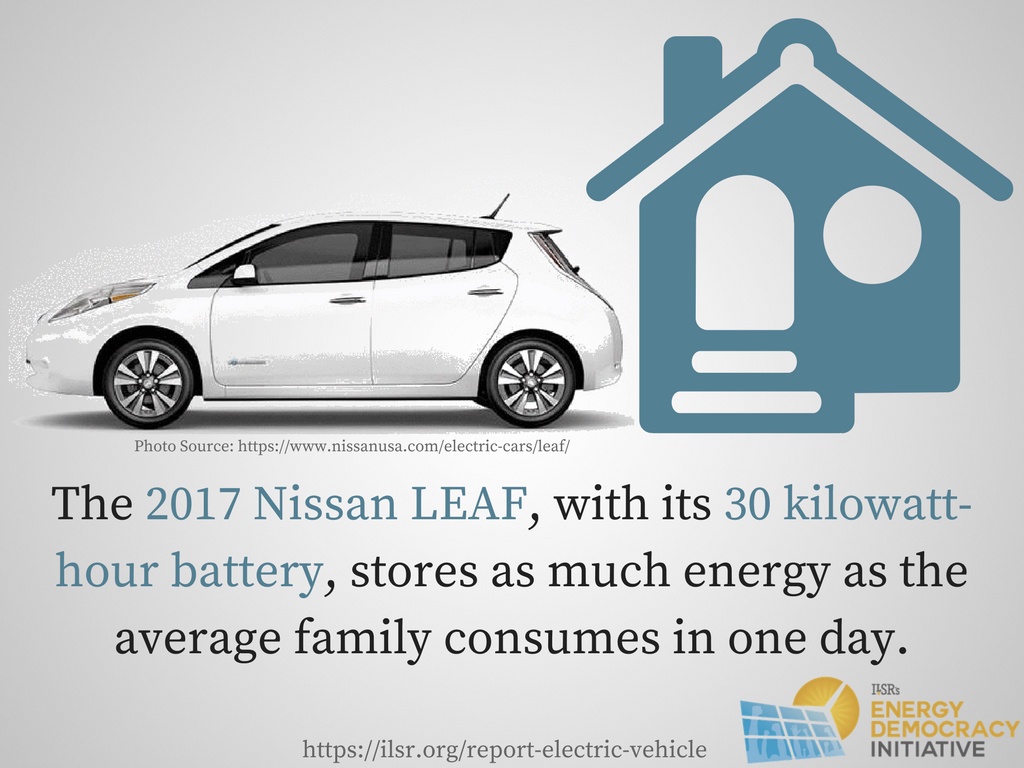
This report explores how electric vehicles will compete with gasoline-powered cars and the widespread implications beyond transportation. It shows how electric vehicles can stave off an electricity sales slump, bolster renewable generation, and make the grid more efficient and resilient. In addition, this report also explores how electric vehicles can move the U.S. toward energy democracy — decentralizing and distributing local power generation, and the ownership of the energy system.
[RETURN TO TOP]
Electric Vehicles Going Mainstream
Sales of electric cars are growing. Technology improvements in the new millennium have solved the shortcomings of earlier models, providing longer ranges, improved battery technology, and competitive pricing. Juiced by favorable federal, state, and local policies as well as the increasingly positive image of electric vehicle ownership, the electric-drive tide is rising.
In just the first quarter of 2011, for example, more electric cars were sold than General Motors leased throughout the entire 1990s. In 2016, U.S. auto dealers recorded 158,000 plug-in vehicle sales — up more than 30 percent from 2015. The trend shows no signs of stopping, especially as more sophisticated production technology drives down vehicle costs, and even as automakers continue to advertise their non-electric models far more often.
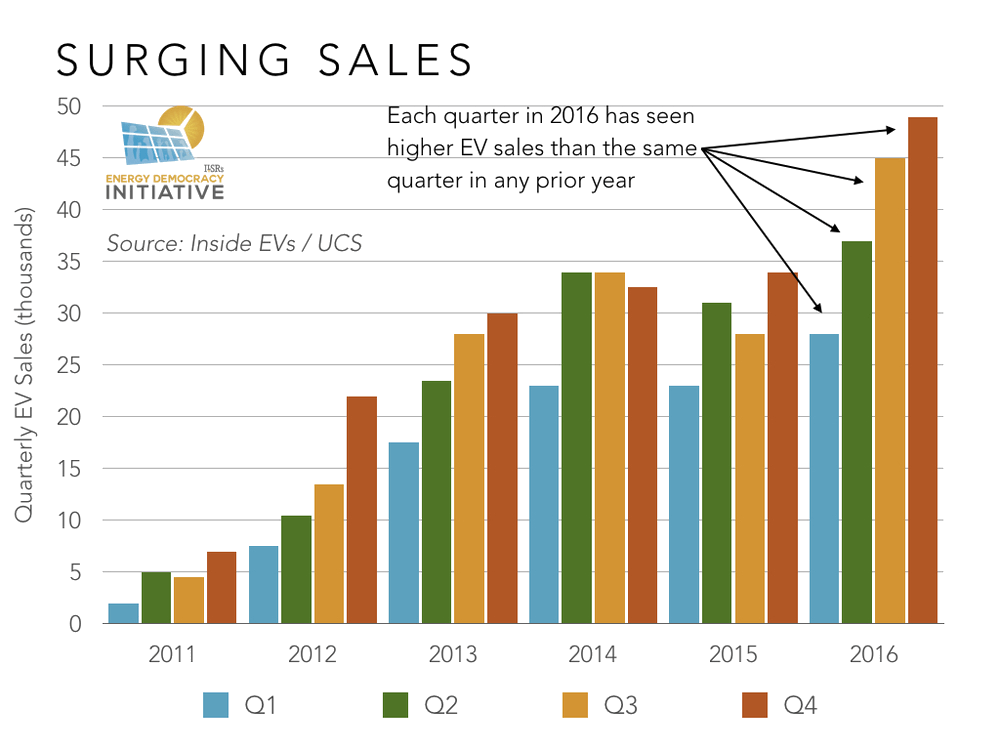
Buoyed by cost-competitiveness, many forecasts show electric vehicle sales ramping up. Bloomberg New Energy Finance expects electric vehicles to comprise 35 percent of global auto sales worldwide by 2040. Other forecasts vary widely. The chart below shows various projections or targets set by four different organizations.

If electric cars penetrate the global marketplace as deeply as Bloomberg predicts, they would displace demand for 13 million barrels of crude oil per day (over 13% of worldwide use) while using 2,700 terawatt-hours of electricity — equal to 11 percent of global electricity demand in 2015.
Bloomberg New Energy Finance expects electric vehicles to comprise 35 percent of global auto sales worldwide by 2040. If they penetrate the global marketplace that deeply, they would displace demand for 13 million barrels of crude oil per day (over 13% of global use).
An Innovation Hotspot
Despite being the most prominent electric vehicle manufacturer, Tesla is not the only player looking to cash in on electric car technology. A healthy growth outlook for the industry has lured multiple technology companies into the space alongside many traditional auto manufacturers.
Tech giant Apple spent more on its electric vehicle research and development than all major automakers, according to a May 2016 report by Morgan Stanley analysts. At that time, the company had outspent even Tesla by more than 10 to 1, and invested more in its budding vehicle business than it had on the Apple Watch, iPad, and iPhone combined. Although it has since changed course to focus on vehicle software, the company had planned to release an electric vehicle by 2019.
The following sections illustrate the factors behind the recent and forecast growth in electric vehicles.
Range Concerns Diminishing
Today’s electric vehicles would generally need more frequent fueling than gasoline cars if home or workplace charging were not possible. The 2017 Nissan Leaf, a popular battery-powered vehicle, can travel up to 107 miles on a single charge in optimal conditions.
While the Leaf covers much less ground than the 350-400 miles offered by a single tank of gasoline in other vehicles, it already satisfies most drivers’ daily needs (Americans cover an average of 29 miles per day and a median of just 10 miles). Eighty-three percent of Americans’ daily auto travel covered less than 60 miles, according to a periodic government survey of driving habits last conducted in 2009.
With today’s electric vehicles already able to cover most drivers’ daily travel needs, and generally able to refuel completely each night, the extended range of next-generation electric cars will all but eliminate the issue of “range anxiety.” A recent test drive of a pre-production Chevy Bolt found it exceeded the EPA-listed range of 238 miles on a drive along the California coast. Cross-country travel may still require fewer stops with a gas-powered car in 2020, but too few Americans routinely travel long distance to sufficiently affect the overall adoption of electric vehicles in the near term.
The following graphic (taken from this Vox piece) illustrates the evolution in the next two to three years.
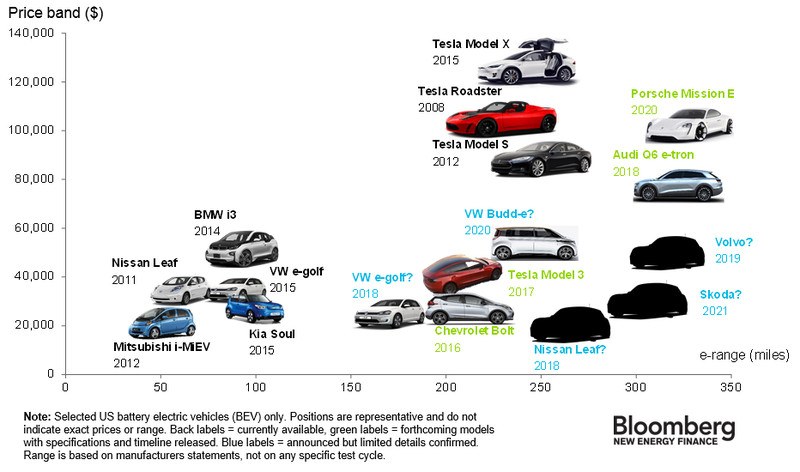
Falling Cost of Ownership
With operational differences diminishing, electric vehicles are also approaching price parity with gasoline cars. The trend is driven by falling component and total vehicle costs, in addition to lower operations and maintenance costs.
Better Battery Prices Make Electric Cars Competitive
The sunny forecast for electric vehicles comes as the cost of their batteries falls. The price of lithium-ion battery packs — typically comprising one-third of a vehicle’s cost — dipped an average of 8% each year between 2007 and 2017. Battery prices dropped 35% last year alone, compounding steep reductions logged in the previous years.
Battery prices dropped 35 percent last year alone.
The trend is slated to continue, with battery packs expected to cost just one-quarter of their 2010 price by 2022, a shift that by itself reduces the price of electric vehicles by about 25%. The following chart shows the forecast steep declines in battery costs, albeit at a slower pace than the previous five years.
The shrinking battery costs lead Bloomberg to forecast that electric cars will undercut gasoline cars on price by the mid-2020s.
Tesla’s Supercharged Role
As the sole electric-only car company, Tesla leads electric car manufacturing and is in hot pursuit of less expensive batteries for its models. Based on research conducted at its first-of-its-kind Gigafactory, Tesla aims to maximize efficiency in battery production to shave down costs. From 2008 to 2015, Tesla halved the cost of its battery packs despite expanding energy capacity by roughly 60 percent in the same span. This combination of lower costs and significantly more capacity means the relative cost savings on a kilowatt-hour basis are greater than if the company’s battery innovation either reduced costs or increased capacity alone.
Tesla’s scale makes it an outsized player in battery development. Because Tesla holds a larger share of the U.S. electric vehicle market than any other company — 20 percent in 2016, in addition to supplying batteries for other automakers (including for Toyota’s RAV4) — its battery costs likely influence the overall marketplace in a significant way. With increasing scale for Tesla, and other car manufacturers, battery costs are expected to continue falling rapidly.
Sticker Price v. Cost of Ownership
By the 2020s, electric vehicles may be more economical than gasoline or diesel cars in many countries. But the purchasing shift may come even sooner.
A study from the International Energy Agency in 2013 suggested that the ownership cost of an electric vehicle (including fuel and maintenance, not just the sticker price) would break even with ownership expenses for traditional cars when battery cost dropped to $300 per kWh of storage capacity. Top battery manufacturers had already hit that mark by 2016.
Fuel cost savings are a good illustration of the ownership benefits of electric cars. Without any special charging rate, drivers in all 50 states would save a minimum of $740 per year and up to $1,500, a discount ranging from 38% to 80% of the cost of driving 15,000 miles. With special rates for overnight (“off-peak”) charging — already available from several utilities for around $0.03 per kilowatt-hour — the average savings of driving electric rise from $1,000 to nearly $1,500 per year. The savings remain significant even when a driver covers only 10,000 miles per year (see Appendix C for more on the calculations).
With special rates for overnight (“off-peak”) charging — already available from several utilities for around $0.03 per kilowatt-hour — the average savings of driving electric rise from $1,000 to nearly $1,500 per year.
Maintenance costs are also lower for electric vehicles. Clean Disruption author Tony Seba notes that electric vehicles have 100 times fewer moving parts in the drivetrain than cars powered by internal combustion engines. They do not require oil changes, transmission fluid, or timing belt replacements. Electric vehicles’ regenerative braking reduces brake wear. Edmunds estimates a 2017 Nissan Leaf will have five-year scheduled maintenance costs of about 15% less than the gasoline-powered Nissan Versa, for example (other sources suggest the advantage lands closer to 25%). The infographic below compares the Nissan maintenance schedules for a Versa with the all-electric Leaf.
Though they require less scheduled maintenance, electric vehicles may need battery replacement. A Nissan Leaf can be expected to lose approximately one-third of its range in the first 10 years of driving (if the car averages 12,500 miles per year). However, the 30-kilowatt-hour battery originally priced near $10,000 in 2016 is likely to cost $3,000 or less to replace in 2026 — less than the accumulated scheduled maintenance savings.
The following chart combines expected fuel and maintenance savings of electric vehicle ownership over 10 years and deducts the expected battery replacement cost. It is likely conservative, as it does not factor in unscheduled or common repairs unique to gasoline-powered cars including belts, pumps, gaskets, or hoses.
Policy and Pride at Play
Electric vehicles sales are also aided by federal and state policy, and a desire for individuals, governments, and agencies to be perceived as leaders.
Policy Aids
A $7,500 federal tax credit reduces the cost of an electric vehicle by 10% or more, and is available for each auto manufacturer until they sell 200,000 plug-in hybrid and battery-powered vehicles (a few automakers are at least halfway to the cap). Several states chip in rebates or credits of their own. In California, whose policies seeded the national electric vehicle boom, qualifying drivers can unlock benefits worth up to $12,000 when they buy or lease an electric vehicle.
Some states offer a non-monetary incentive that may be even more attractive than cash. Ten states allow electric vehicle drivers unrestricted access to high-occupancy vehicle (HOV) or carpool lanes. In California, according to surveys, the right to drive in the carpool lane has been a compelling benefit. In a 2013 survey, when vehicle buyers were asked about their primary motivation to buy a plug-in car, 57% of plug-in Toyota Prius, 34% of Chevy Volt and 38% of Nissan Leaf owners singled out t free access to carpool lanes. The benefit expires in 2019.
Seven states, including California, require their combined zero-emission vehicle sales to rise to 3.3 million by 2025 (in many states, including California, this includes a combination of all-electric and plug-in hybrid electric cars). In California, each automaker must amass a certain number of credits each year, with companies like Tesla selling millions of dollars in credits to rivals without robust zero-emission offerings. Many states also provide rebates or tax credits for electric vehicle purchases or home charging installation. The following map, based on data from the National Conference of State Legislatures, summarizes these policies.
In a decisive victory for public policy, as incentives begin phasing out, the underlying economics of electric vehicles render these benefits less necessary.
‘Conspicuous Conservation’ or Sex Appeal
The Toyota Prius, a hybrid vehicle powered by a mix of gas and electricity, generated plenty of buzz when it made its worldwide debut in 2000. About a decade later, the automaker had sold 1 million of them in the U.S. alone, earning it repeat appearances on car bestseller lists. The Prius is considered reliable and is affordable, but other factors amplify its appeal.
In an oft-cited 2011 paper, Sexton and Sexton found that “conspicuous conservation” — the idea that our society prizes environmentalism and rewards a lack of consumption — motivated many drivers to choose the Prius. Electric vehicle ownership is one of the most visible consumption decisions a household can make, they argue. That goes double for the Prius, whose distinctive design separates it from other hybrid and plug-in vehicles that look much more like traditional gas-powered cars.
“The status conferred upon demonstration of environmental friendliness is sufficiently prized that homeowners are known to install solar panels on the shaded sides of houses so that their costly investments are visible from the street.”
-
Sexton and Sexton, Conspicuous Conservation: The Prius Effect and Willingness to Pay for Environmental Bona Fides
The cultural emphasis on eco-conscious thinking has deepened since Prius sales took off. Now, it is bolstering cachet for manufacturers like Tesla and others carving out slices of the fast-expanding electric vehicle market.
Tesla has proved to have its own sex appeal, beyond eco-consciousness. Tesla CEO Elon Musk reported in April 2016 that his company’s forthcoming Model 3, priced at $35,000, had garnered about 400,000 reservations. The vehicle wouldn’t go into production until at least 2017, and each reservation required a $1,000 deposit. A Jefferies analyst surveyed 145 Tesla owners in June 2015, when the least-expensive Tesla model available had a $58,000 sticker price and most of Tesla’s vehicles cost substantially more. About 70% of respondents said they switched to Tesla from cars that cost less than $60,000. Overall, they were willing to pay an average of 60% more than their previous car to own a Tesla.
The automaker also ranks first in customer satisfaction surveys, with 91% of owners saying they would buy the same car if they were repeating their shopping process, 7 percentage points more than the next car company, Porsche. Speaking of sports cars, the Tesla Model S is among the top three fastest accelerating cars in the world, the P100D model is the world’s fastest production car. Plus, it still earned a top safety rating from the National Highway Traffic Safety Administration and narrowly missed a superior mark from the Insurance Institute for Highway Safety. It also has ranks highly for cargo space.
Tesla aside, many other hybrid and electric cars rank as high as luxury cars in customer satisfaction.
In other words, hybrid and all-electric vehicles boast a unique appeal that car shoppers consider alongside performance, cargo space, and other common characteristics.
Leading by Example with EV Fleets
Utilities and local governments have also helped spur electric vehicle adoption by procuring them for municipal official business, as “fleet” vehicles. The Sacramento municipal electric utility, for example, has over 20 electric vehicles in its current fleet and plans to increase that number five-fold in the next five years.
The New York Power Authority has pumped $8 million into an initiative to help municipalities and rural electric cooperatives transition their fleets to electric vehicles. The program’s first $5 million allowed 24 towns and villages across New York to buy 61 electric vehicles, aligning with a state goal to cut greenhouse gas emissions by 40 percent by 2030 (compared with 1990 levels).
Separately, New York City is beating expectations for integrating 2,000 electric vehicles to its fleet — among them battery-powered sedans and ambulances — by 2025. The fleet is on track to have 1,000 electric vehicles by the end of 2017, with ample time to double that figure. In addition, Mayor Bill De Blasio has committed $10 million to build out charging infrastructure across the city, part of a plan to encourage private electric vehicle ownership.
Adding just 27 Nissan Leafs to the fleet saves the city $110,000 per year, compared with gas-powered vehicles.
Perhaps a more unexpected leader in municipal fleet conversion is Houston. A city at the center of the U.S. oil industry, it began examining “green transportation” in 2002. With more than 9,200 vehicles, Houston’s fleet is among the nation’s largest. As of 2013, more than half of its light-duty vehicles were hybrids, and the city had begun to add more plug-in cars (including by converting some of its hybrid vehicles). A study revealed that adding just 27 Nissan Leafs to the fleet saves the city $110,000 per year, compared with gas-powered vehicles.
[RETURN TO TOP]
Impact: Improving the Grid
Electric vehicles boost demand for electricity.
On one hand, that’s great news for utilities. The average electric-powered car driver covers 12,000 miles annually, and one study calculated that the additional 4,000 kilowatt-hours used by an electric vehicle would increase a typical household’s yearly energy need by 33 percent (without adoption of energy efficiency measures). In small numbers, electric cars will change little, but in large numbers they could reverse the stagnant growth in electricity use, which has dropped in five of the last eight years and affected the bottom line of many electric utilities.
On the other hand, could this increased demand also increase the cost of operating the electric grid (and costs for electric customers) by shortening the life of grid components, requiring replacement or upgraded infrastructure such as transformers and capacitors, or even building new fossil fuel power plants?
Fortunately, the evidence suggests that electric vehicle expansion will reward, not ruin, the grid and its customers.
A rigorous analysis spearheaded by the California Public Utilities Commission in 2016 found substantial net benefits in electric vehicle adoption for the state’s electric grid and customers: worth $3.1 billion by 2030, even without smart charging policies and with vehicle adoption clustering in particular areas of the grid. This included the benefits of capturing federal tax credits, gasoline savings, and carbon credits in California’s greenhouse gas allowance transportation market plus all of the associated costs to the customer and grid.
The study also found surprisingly low costs for upgrading the local distribution grid. Even with a much higher vehicle adoption assumption of 7 million cars by 2030 (one-quarter of all registered vehicles), annual distribution infrastructure costs would be just 1% of the annual utility distribution budget.
A rigorous analysis by the California Public Utilities Commission found substantial net benefits in electric vehicle adoption: $3.1 billion by 2030, even without smart charging policies and with vehicle adoption clustering in particular areas of the grid.
A set of studies for northeastern states found a similar net benefit, even without smart charging policies, for vehicle owners, utilities, and society.
Relatively simple policy changes can enhance the payoff of adding thousands or millions of electric vehicles to the grid. California’s study suggests that the most potent and simplest tool to smoothly integrate electric vehicles is controlling when they charge. This can be done with special rates that give customers a discount for charging at grid-friendly times, or even using special chargers that disallow charging when grid demand is at its highest. These tools increase the efficiency of the electricity system, but also mean lower-cost fuel for electric vehicle owners, a win-win.
Relatively simple policy changes can enhance the payoff of adding thousands or millions of electric vehicles to the grid. California’s study suggests that the most potent and simplest tool to smoothly integrate electric vehicles is controlling when they charge.
In an exhaustive analysis using time-of-use (TOU) pricing to strongly incentivize nighttime charging, the California Public Utilities Commission found that shifting from flat-rate to time-of-use charging increased net benefits from $3,600 to $5,000 per vehicle through significant reductions in the energy and infrastructure costs of charging.
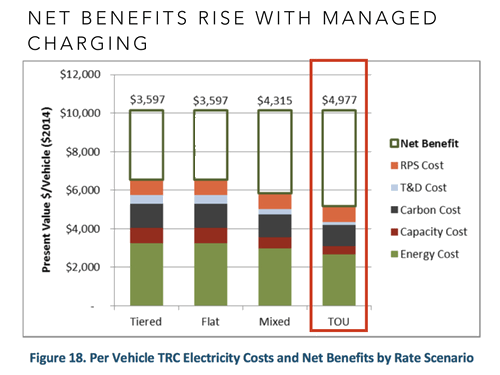
While the California calculation includes the federal tax credit, the benefits are expected to persist even when that incentive expires because of falling electric vehicle and battery costs.
This following sections explore pricing tools that allow utilities and regulators to better manage grid supply and demand, rather than building new power infrastructure that could be obsolete early in its decades-long life.
EV Charging Terminology
A quick note on charging before we dive in. Electric vehicles can be charged at different speeds by using different voltages. A standard 120-volt outlet can deliver about 1.3 kilowatts per hour but may take 12 or more hours to fully charge a vehicle. A 240-volt circuit can deliver a substantially faster charge and can be wired in a typical home or business. Direct current (DC) fast charging uses 440-volt charging that can “refuel” an electric vehicle battery in less than an hour. The following graphic from FleetCarma illustrates.

Managing Demand
With proper price incentives, grid managers can motivate electric vehicle users to avoid charging during periods of peak demand, to instead charge when demand is otherwise low, and to help smooth out large increases or decreases in demand.
The electric grid is designed around periods of peak energy use, with requirements for significant energy reserves dictated by the single-most congested hour of the year. By raising electricity prices at times of peak energy use (and reducing them elsewhere), utilities can largely minimize electric cars’ contribution to peak energy demand. Recent modeling by the Rocky Mountain Institute suggests optimized charging rates would limit Minnesota’s peak demand increase, for example, to just 0.5 percent when electric vehicles hit 23 percent penetration, compared with an increase of more than 3 percent without charging controls.
Minnesota wasn’t alone. In the four other states modeled, the Rocky Mountain Institute found peak demand impacts of widespread electric vehicle adoption could be significantly reduced with controlled charging. The following graphic illustrates.

Utilities can also leverage electric vehicles to manage rapid changes in electricity demand. Historically, these ramps up or down have been driven by a morning surge in demand as people wake up and turn on lights and appliances, and another in the evening when stores remain open and residents return home. In some cases, these ramps are also influenced by rooftop solar generation, which sharply reduces demand from solar-powered neighborhoods in the daytime but spurs a sharp increase in local demand in the evening when residential demand increases as the sun sets.
Utilities typically prepare for these surges by activating gas power plants that can be put on standby or ramped up quickly. However, because these plants are relatively under-utilized, the electricity provided at peak periods is expensive. An August heat wave in Texas, for example, sent hourly electricity prices on the grid well over $1 per kilowatt hour on several occasions, more than ten times the usual price.
Utility wonks illustrate this challenge with the “duck curve,” shown below for the California Independent System Operator (CAISO). The issue is the steep curve starting around 4 p.m. and peaking around 8 p.m., driven largely by adoption of rooftop solar that drives down daytime electricity demand. One caveat: the deep dip is sometimes called “overgeneration” — implying that there’s too much solar energy production — an issue enhanced when the bottom axis reflects a minimum of 14,000 megawatts. One German observer notes that this issue (as opposed to the ramp) is exaggerated. For context, the chart is also shown with a zero axis.
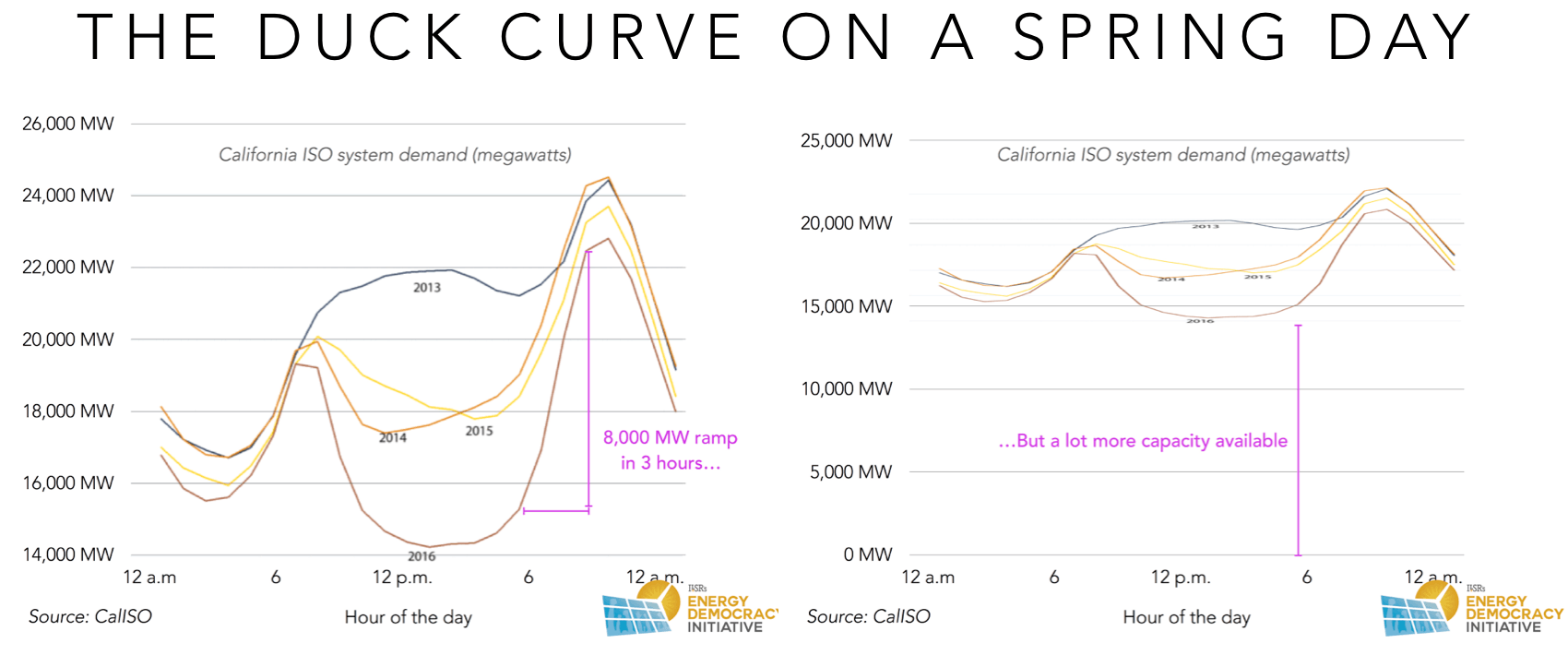 Although there are many potential solutions (the linked report from the Regulatory Assistance Project is particularly thorough), electric vehicles can help smooth the curve. By drawing power from the grid during the midday hours when solar output is greatest, electric vehicles can soak up the sun-generated power and in turn reduce the evening ramp-up. Fortunately, data from California suggests that 40% of electric vehicles remain at home even through the midday hours. If vehicle owners have access to charging at home and at work, over 70% of vehicles are available to absorb excess daytime electricity generation.
Although there are many potential solutions (the linked report from the Regulatory Assistance Project is particularly thorough), electric vehicles can help smooth the curve. By drawing power from the grid during the midday hours when solar output is greatest, electric vehicles can soak up the sun-generated power and in turn reduce the evening ramp-up. Fortunately, data from California suggests that 40% of electric vehicles remain at home even through the midday hours. If vehicle owners have access to charging at home and at work, over 70% of vehicles are available to absorb excess daytime electricity generation.
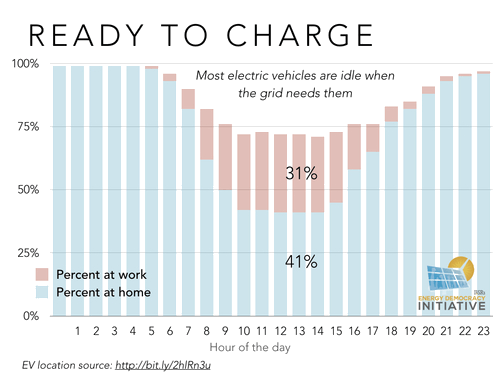
By charging these idle electric vehicles during daytime hours, grid operators could reduce the steep afternoon ramp-up in electricity demand. The chart below illustrates how charging these vehicles between 11 a.m. and 4 p.m. would help smooth the rise in demand, giving grid managers more time to accommodate increasing electricity consumption.

The amount of additional demand needed from electric vehicles to achieve this outcome is well within projected capacity. The 1.5 million electric cars California expects by 2025 would have a maximum energy demand of about 7,000 megawatts, more than double the capacity needed to substantially smooth the current afternoon rise in peak energy demand.
As discussed later, widely distributed charging infrastructure will be key to accessing this resource, as few homes or businesses currently have car chargers. Furthermore, the amount and availability of bill credits or compensation for grid exports (or in the case of Hawaii, a tariff that provides no payment for excess solar production) will strongly impact customer behavior.
Soaking Up Supply
Charging controls or pricing incentives can also motivate electric vehicle drivers to charge overnight, or whenever clean energy production is strongest.
In markets like the Midwest that have abundant wind power, clean energy production often peaks overnight when demand is lowest. The chart below shows the daily demand curve for the Midwest Independent System Operator, which serves a number of states in the Midwest. The 50,000 megawatt-hour gap between daytime and nighttime demand (in July, when the grid is built to accommodate daytime load boosted by air conditioning) could accommodate over 7.5 million electric vehicles on Level 2 (240-volt) chargers without building a single new power plant. That’s almost 2 million more cars than the total number registered in the entire state of Illinois.
The 50,000 megawatt-hour gap between daytime and nighttime demand could accommodate over 7.5 million electric vehicles on Level 2 (240-volt) chargers without building a single new power plant.
The hungry batteries of electric vehicles can also be coordinated to improve the capture of wind and solar power.
The most common constraint in a grid with high levels of renewable energy (over 30%) is overgeneration. This happens when there’s so much renewable energy available that making room for it would mean ramping down or turning off inflexible power plants (coal, nuclear, hydro). In electricity markets, renewables tend to undercut any other resource because — having no fuel — they have almost no marginal cost to produce electricity.
Electric vehicles represent a new source of electricity demand that can absorb this excess production.
Charging electric cars during nighttime low-demand periods, for example, means increasing the use of wind energy. A 2006 study from the National Renewable Energy Lab found that electric vehicle deployment “results in vastly increased use of wind” because overnight vehicle charging overlaps with windier nighttime conditions. A 2011 study from the Pacific Northwest National Laboratories found that if one in eight cars were electric, the additional storage capacity would allow the Northwest grid to handle 12% more wind energy.
Electric vehicles can also help grids put more solar power to use. The illustration in the previous section — Ready to Charge — illustrates how most electric cars could be available to charge during afternoon hours to absorb solar energy output, although it requires daytime charging (and potentially non-home charging infrastructure) that nighttime charging does not.
Portuguese researchers found that growth in both solar generation and electric vehicles maximizes the grid benefits of each. Portugal’s heavy emphasis on solar generation means that, as time goes on, it will build up a “substantial amount” of excess daytime solar energy. Because neighboring countries are also building out their solar portfolios, Portugal’s exports would yield low prices, suggesting that solar power might be curtailed (or lost) instead. But researchers found that an expanded electric vehicle fleet — and a preference for midday workplace charging — could decrease the midday solar surplus by 50%.
A separate Portuguese study includes analysis of simulated solar production during a given week in April. With no electric vehicles, 202 gigawatt-hours — or 48% of solar production — was curtailed during that span. With electric vehicles added to the mix, curtailment fell to 123 gigawatt-hours, or 29% of solar production.
Together, solar and electric vehicles can do more to smooth the demand curve than either technology could on its own. The following chart, from the Rocky Mountain Institute, shows how optimized electric vehicle charging increases daytime electricity demand by over 200 megawatts (nearly 14% of peak demand) in Hawaii, allowing for more solar production.
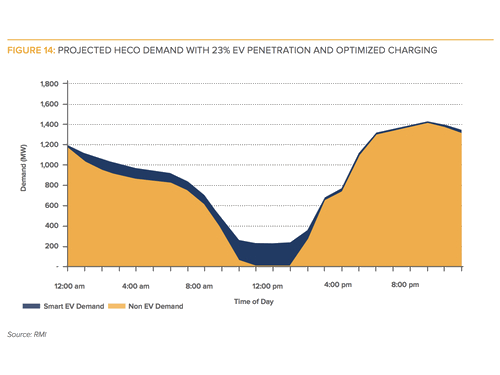
Other studies confirm this potential. A 2012 study by the Imperial College of London, for example, suggests that energy storage, including electric vehicles, can reduce curtailment of renewables by more than half.

Providing Ancillary Services to the Grid
 By starting, stopping, or varying the level of charge, electric vehicle batteries can provide two crucial “ancillary” services to the grid: helping maintain a consistent voltage (120 volts) and frequency (60 Hertz). These services are provided by short bursts of “reactive” power: either drawing power from the grid or putting it back in. Since nearly all commercially available electric vehicles lack the ability to send power to the grid, car batteries would provide reactive power today only by drawing power (charging).
By starting, stopping, or varying the level of charge, electric vehicle batteries can provide two crucial “ancillary” services to the grid: helping maintain a consistent voltage (120 volts) and frequency (60 Hertz). These services are provided by short bursts of “reactive” power: either drawing power from the grid or putting it back in. Since nearly all commercially available electric vehicles lack the ability to send power to the grid, car batteries would provide reactive power today only by drawing power (charging).
The vehicle’s ability to aid the grid also hinges on the power of its charger and the ability to aggregate with other vehicles. On a typical home 120-volt outlet allowing up to 1.3 kilowatts of power per vehicle, it would take over 250 vehicles to reach the minimum threshold to provide ancillary services in energy markets run by regional grid operators PJM or MISO, which cover a substantial portion of the U.S. A 240-volt Level 2 charger with a capacity as high as 6.6 kilowatts per car significantly reduces the number of vehicles needed (as few as 27) to join the market.
Electric vehicles can provide substantial value to the grid as they charge (and in the future, perhaps by supplying power back to the grid, see Appendix A — The Vehicle-to-Grid Future).
[RETURN TO TOP]
Impact: Cutting Pollution
One major benefit of electric vehicles is reducing pollution impacts of driving. The following chart shows the greenhouse gas emissions from electric vehicles based on the grid electricity supply in 2015. The numbers on the chart are the miles per gallon required from a gasoline-fueled vehicle to have the same greenhouse gas emissions impact as an electric vehicle. The numbers will have risen since 2015, as additional coal plants have been retired.

Driving electric also significantly reduces other pollutants. The adjacent chart is from a 2007 study of the pollutant impact of hybrid and plug-in hybrid cars in Minnesota. It assumes a grid with a mix of 40% wind power and 60% coal power. The former is likely in the next decade, the latter is laughable in the face of a massive switch from coal to gas and renewables. With that context in mind, the bar representing sulfur dioxide should be ignored as the emissions rate of sulfur dioxides is 99% lower with natural gas, and 100% lower with more wind or solar power.
[RETURN TO TOP]
Impact: Readying Energy Democracy
The cumulative power of electric vehicles goes beyond stabilizing the larger electricity system; it offers an opportunity to draw more power from the local economy. Electric vehicles operate in a distinct geography (near the owner) and therefore their benefits are localized. This makes electric vehicles part of a larger transition from energy monopoly to energy democracy, as distributed technology from solar to smartphones localizes everything — production, consumption, and decision making — on the electric grid.
The following graphic illustrates the shift from energy monopoly to energy democracy. The flow of electricity changes from one-way to two-way as many customers install rooftop solar and purchase electric vehicles. The share of renewable energy grows and that of fossil fuel power shrinks. In general, the community sources more of its energy locally.
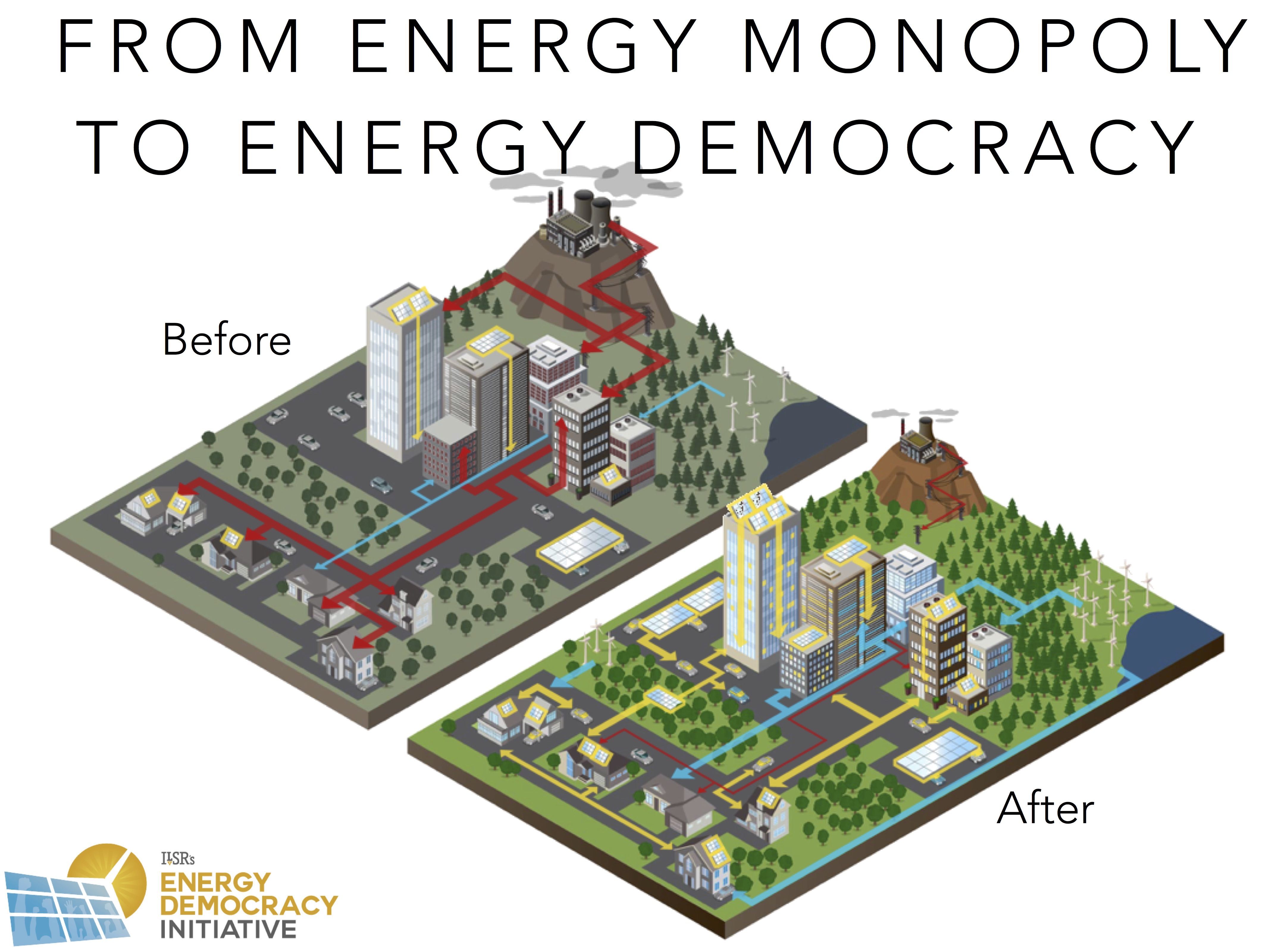
This section details the three key local benefits of electric vehicles: enabling the combination of the “sexy electrics” (solar and electric cars); increasing the capacity for local distributed solar energy production; and providing resilient, local backup power.
Complementary, Sexy Technology
Electric vehicles can encourage increased deployment of distributed solar. The same environmental values and spending habits that helped rocket the Toyota Prius to 1 million sales in a decade propel people to install solar panels. Like the conspicuous sustainability credential provided by the unique Prius, economists have speculated that homeowners invest more in solar panels than more affordable insulation and caulking. As such, it is not surprising that two of the clearest signals of green values — electric vehicle ownership and rooftop solar installation — often go hand-in-hand.
In California, roughly 39% of electric vehicle drivers also owned residential solar in 2013 — far outpacing the general population in the U.S., where less than 1% of all households had rooftop arrays through the second quarter of 2016. Meanwhile, 17% of California electric vehicle drivers expressed “strong interest” in installing solar in the near future. Of those that already had both, 53% said they sized their at-home solar systems with electric vehicle charging in mind, exposing synergies that reduce grid strain and help accommodate higher electricity demand.
Boulder County, CO, captured this complementary relationship by offering a program that promoted bulk buying for electric vehicles and solar. Area residents could opt in to access discounts on their purchase of either upgrade. The initiative provided a significant boost to electric vehicle sales. During the September-to-December promotional period, a local dealership sold 85 Nissan Leafs in 2013 and 2014 before jumping to 173 in the same period in 2015. Boulder County, home to less than one-tenth of 1% of the U.S. population, accounted for 3.5% of all U.S. Leaf sales over that span.
Meanwhile, program participants installed 147 solar arrays totaling 832 kilowatts. At least 19 households (over 10% percent of those participating) purchased both a Leaf and a solar array, and of that group, 11 right-sized their solar project to ensure it could power both their home and their new electric vehicle. By harnessing the federal electric vehicle tax credit alone, participants brought $1.8 million into the local economy — a huge gain, considering Boulder County estimated the program required just 165 hours of staff time and $650 in out-of-pocket expenses. The program was aided by the state electric vehicle tax credit, worth about $3,800 per car or $660,000 altogether.
The relationship between solar and electric vehicles may not remain as tight in the long term. A 2016 survey of plug-in car owners found that the percentage owning a solar array had fallen from 25% in 2012 and prior to 12% in 2015. This could be due to less affluent car owners or vehicle sales in areas with poorer solar resources. On the other hand, it also means that electric vehicles are dispersing beyond the very savvy customers that already own solar.
Either way, electric vehicles and solar arrays are both appealing to consumers, in a way that other energy improvements are not. And fortunately, this marriage of sexy electrics delivers benefits to the grid and local economy.
Electric Vehicles and Community Solar?
As electric vehicle ownership expands, it will reach many Americans who lack a sunny rooftop but may still have interest in solar. Community solar programs allow these customers to invest in or subscribe to solar energy projects, and the revenue from these subscriptions could offset the cost of charging an electric vehicle. It also allows them to, indirectly, charge their car from the sun.
The technical benefits of marrying solar and electric vehicles using community solar would be diminished unless customers subscribed to a community solar array located on the same distribution feeder as their primary place of vehicle charging.
Increasing Local Energy Capacity
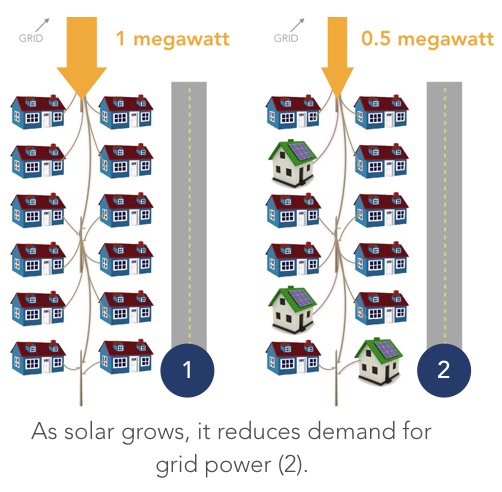 Electric vehicles boost electricity demand and expand local storage, increasing capacity to produce more electricity from local, renewable sources.
Electric vehicles boost electricity demand and expand local storage, increasing capacity to produce more electricity from local, renewable sources.
Solar energy, for example, can reduce a neighborhood’s peak energy consumption. If a community is served by a distribution line with a maximum capacity of 1 megawatt and it’s running near that limit, the utility may consider an expensive hardware upgrade. But adding local solar can reduce demand during hot, sunny summer afternoons, potentially allowing the utility to defer that upgrade.
We illustrate the effect in the graphic to the right. If many homes and businesses in a neighborhood add rooftop solar, it supplants power from the grid with local energy to avoid new capacity needs.
As solar continues to proliferate, a second set of issues can arise. Lots of small solar power plants can result in a portion of the local grid remaining energized when there’s a larger blackout. This could cause safety issues for utility workers who would expect power lines they’re repairing to be dead. However, smart inverters for solar arrays can automatically turn off power production when the grid goes dark. An even better solution is to island the home or business with solar, allowing them to have power even when the grid is dark. Newer inverters can supply up to 1500 watts for use during blackouts, even as the solar array stops sending power to the grid.
A second issue is a technical and competitive concern called “backfeed.” Backfeed is what happens when the supply of electricity (including from local solar) exceeds total use on a certain area of the grid. In this case, power flows back onto the grid, as shown in the illustration below.
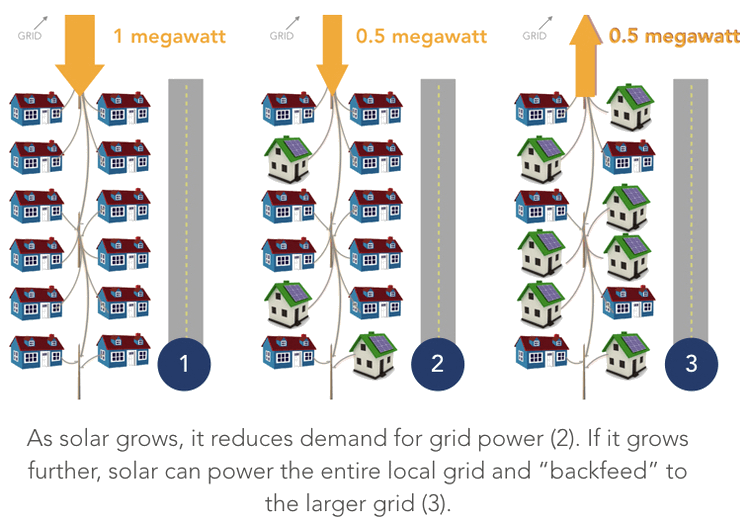
This may require substation upgrades to mediate power flow from the high-voltage regional grid to the low-voltage local grid, which weren’t designed with this flow in mind. It also allows local solar generation to compete against many other sources of electricity, including traditional fossil fuel power plants. In the many states where the utility company is responsible for grid safety and owns power plants that would be in competition with local solar, this creates a challenging conflict of interest.
Electric vehicles can solve backfeed issues by absorbing more local power generation, in turn enabling it to serve local needs. This also reduces wear and tear on utility hardware, inevitable in longer-distance power distribution. The following illustration shows how increasing electric vehicle ownership can reduce solar energy exports to the larger grid.

Without an additional local source of energy consumption, utilities can “curtail,” or effectively shut off, clean power production from local solar arrays. But a 2016 study in Hawaii confirmed that more electric vehicles on the grid translates to greater potential reductions in curtailed energy. That is especially significant in a rooftop solar stronghold — 17% of utility customers in Hawaii generate their power this way, including at least 32% of single-family homes on Oahu. The study’s authors modeled a scenario where 10% to 30% of Oahu vehicles were electric, and predicted an 18% to 46% reduction in curtailed generation when vehicle charging was controlled to match local power production. In this model, wind and solar provided close to 50% of the island’s total electricity needs.
The authors cautioned that marked day-to-day fluctuations in wind and solar curtailment obscure the precise effects of controlled charging in capturing curtailed energy, but found that using electric vehicles to integrate more storage makes distributed generation more valuable, more effective, and even more pervasive.
It’s a scenario that could play out in markets across the country. For example, the California grid operator CAISO reported 132 megawatt-hours in local curtailments of solar generation between 10 a.m. and 2 p.m. on Sept. 15, 2016. These curtailments were due to a limit on the capacity of the local grid to export. Typically, such curtailments involve utility-scale solar. If the capacity of the average electric car battery is 30 kilowatt-hours (the size of that in the 2017 Nissan Leaf), 8,800 parked electric vehicles needing a 50% charge could collectively offset that day’s curtailment, benefiting those generating solar power and helping to stabilize the grid.
Local Value
Sourcing power locally has two spillover benefits. First, it keeps more of the economic benefits of power generation within a given community. A typical 1-megawatt solar array creates $2.5 million in local economic activity and 20 jobs. Through its 25-year lifetime, a locally owned solar project will redirect an additional $5.4 million of electricity spending back into local hands.
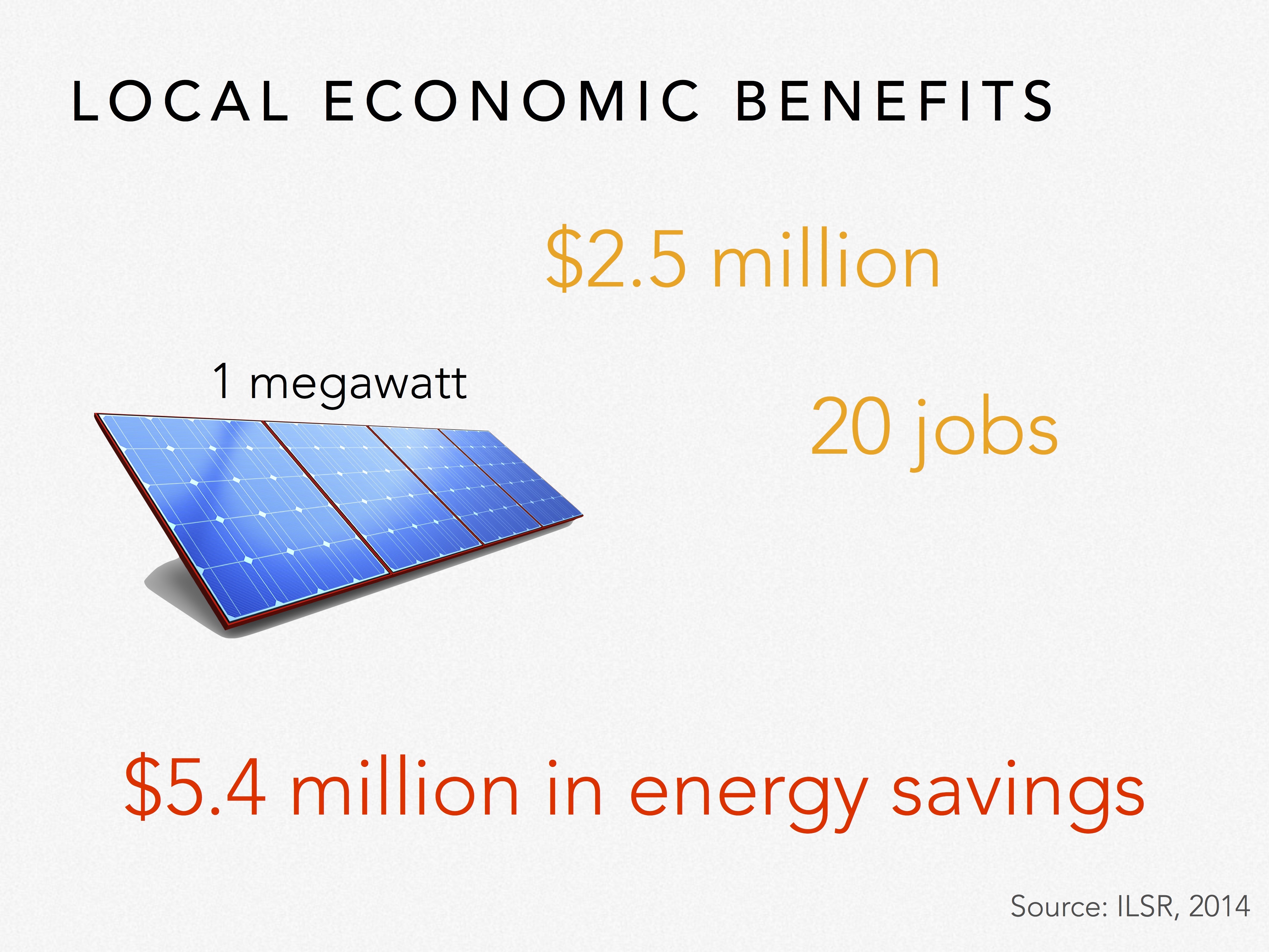 The energy may also be more valuable to the grid if it is consumed locally, as ILSR explains in our 2016 report, Is Bigger Best? In many debates nationwide over the proper valuation of solar, most policy outcomes include a higher value for energy that can be used on-site or locally, rather than exported to the larger grid. Utilities and regulators in Hawaii and New York, for example, have adopted measures for distributed solar that favor on-site consumption.
The energy may also be more valuable to the grid if it is consumed locally, as ILSR explains in our 2016 report, Is Bigger Best? In many debates nationwide over the proper valuation of solar, most policy outcomes include a higher value for energy that can be used on-site or locally, rather than exported to the larger grid. Utilities and regulators in Hawaii and New York, for example, have adopted measures for distributed solar that favor on-site consumption.
Resiliency
Electric vehicles can also provide individuals and communities greater resiliency in the face of natural disaster. In the wake of week-long power outages following Hurricane Sandy, many communities on the East Coast sought ways to reduce their reliance on their (often distantly located) utilities. Many states encourage the installation of solar energy generation and even microgrids, miniature versions of the electric grid that can operate when the larger grid goes dark. Microgrids, typically powered by solar and batteries, could use electric vehicles to soak up excess energy production — and keep it local — to provide power during extended grid outages.
A pilot project at the University of California-San Diego, a campus which supplies more than 90%t of its own energy, equipped its microgrid to host 70 electric vehicle chargers. The microgrid can ramp down charging to reduce campus-wide demand. In turn, drivers who allow flexibility in charging receive compensation when their vehicles perform services like frequency regulation. This symbiosis makes electric vehicle integration a compelling prospect for microgrid operators and vehicle owners.
“The link between a microgrid and an electric vehicle can create a win-win situation wherein the microgrid can reduce utility costs by load shifting while the electric vehicle owner receives revenue that partially offsets his/her expensive mobile storage investment,” researchers wrote in a 2010 study from the Lawrence Berkeley National Laboratory.
While microgrids currently comprise a small portion of the total U.S. electric generation capacity, their numbers are expected to double or triple within a decade — rising in tandem with electric vehicle ownership in the U.S. Particularly as both markets grow, outfitting microgrids with technology to tap into storage and ancillary services from electric vehicles can fortify local power systems. Together, electric vehicles and microgrids promote resiliency.
As noted above, electric vehicles may also offer a resiliency benefit to existing “microgrids” — homes. The typical second-generation electric vehicle battery (such as the Chevrolet Bolt) stores sufficient electricity to power the average American home for two days. This is a powerful secondary benefit for a purchase centered on mobility.
[RETURN TO TOP]The typical 2nd generation electric vehicle battery (such as in the Chevrolet Bolt) stores sufficient electricity to power the average American home for two days.
Rules to Maximize the Electric Vehicle Opportunity
With a virtuous cycle of falling battery costs driving increased electric vehicle deployment, and deployment improving the economics of scale of battery production, the widespread adoption of electric vehicles is likely inevitable. But policies enacted now could influence the timing of widespread use and shape how electric cars benefit the grid. The following section explores how policy can most effectively aid adoption of electric vehicles, in a way that maximizes their economic benefits to the grid and to vehicle owners.
Deploy Charging Infrastructure
Simplifying refueling with widespread vehicle chargers is key to capturing electric vehicle benefits. This means placing chargers strategically and offering sufficient charging speed to match the battery capacity and time available to charge.
For many individual vehicle or even fleet vehicle owners, charging while parked overnight will replace today’s regular visits to the gas station. Typical 120-volt outlets can fully charge cars with a smaller battery (like in the Nissan Leaf), from empty to full, in about 12 hours. However, the next generation of electric vehicles — the ones that will compete directly with internal combustion engines — need more power to refuel completely and quickly.
Charging infrastructure will also need to be available where people park, and not everyone has a handy garage or carport. In a presentation to the California Energy Commission, Nissan noted that fewer than half of today’s 140 million light-duty vehicles have a garage stall available. Over 60% of U.S. residents live in multi-unit housing that may lack charging options, and few workplaces or public spaces today feature vehicle chargers.
The local refueling network for electric vehicles will be substantially different than for gasoline vehicles. Many cars will charge at home overnight, only rarely requiring a public charge. Many more will want access to overnight charging when parked on-street.
This section explores charging infrastructure issues. It begins with long-distance travel, where high-voltage chargers will largely mimic the existing gas station network, then dives into the novel places that will need fueling infrastructure to accommodate a new electric fleet. Finally, it discusses the role of competition, incentives, cities, and autonomous vehicles in building out of electric vehicle charging.
For Long-Distance Travel
High-capacity charging to support long-distance travel is likely to follow the private market model for fueling gasoline-powered vehicles. Charging locations will be determined by vehicle battery capacity and commonly traveled routes. Already, Tesla has built a national network of 145-kilowatt “Superchargers” for its vehicles (shown below), which provide its vehicles 170 miles of range in about 30 minutes. Private company ChargePoint also provides high-voltage 50- to 400-kilowatt “Express Plus” chargers that offer fast charging for all electric vehicle models and are designed with future, higher capacity batteries in mind.

At Homes and Businesses
Placement of chargers in cities may follow different development models, and there’s a compelling case for utilities to be more heavily involved. While typical 120-volt outlets are ubiquitous in homes and businesses, they have two major drawbacks. First, they charge car batteries in hours, not minutes. Second, they tend to be in or attached to buildings, limiting charging options for those who park on the street or away from buildings in parking lots. The solution to both issues is deploying higher-voltage chargers wherever drivers park.
We’ll start with the simplest case: a driver who can park in a garage or driveway close to a building. In a scenario where their car battery has sufficient range and they plug in each night, a typical 120-volt outlet may be sufficient. But for those who want a faster turnaround either for multiple trips in a day, or simply the security of having a full battery sooner, a higher-voltage charger is desirable. For these folks, the barrier is the personal financial cost of such a charger, which usually runs around $1,200 for hardware and installation, split evenly between the charger and the cost to run a higher-amp, 240-volt wire to the charging location.
There’s a compelling case for electric utilities to pay for these chargers, and there are a couple of mechanisms for doing so. One is to provide inclusive, tariff-based financing. Under inclusive financing, the utility fronts the money for energy efficiency or renewable energy improvements (including electric vehicle chargers) on a customer’s property, then recovers the cost over time through the customer’s electricity bills. The timeline for cost recovery provides the customer positive cash flow from day one, but caps repayment costs at 80 percent of the total cost reduction. In this case, since there are no attributable energy savings (on the electric bill, though there are substantial savings at the gas pump), the term could correspond instead with the typical ownership period of a car, about six years.
A second financing option is traditional cost recovery, where the utility pays for the chargers but spreads the cost over the entire customer rate base.
In either case, the long-term revenue stream from electric vehicle charging justifies utility-managed financing. This is a similar approach to giving away light bulbs to drive sales in the early years of electrification. Utilities will see significantly greater revenue from electric vehicle charging. With typical driving patterns, the average household consumes an additional 4,000 kilowatt-hours per year after buying an electric vehicle. The incremental cost to the utility for delivery that energy is minimal, especially if charging plans reward the car owner for avoiding peak energy periods.
If a customer charges their car at the average retail rate of $0.10 per kilowatt-hour (assuming 30%, or $0.03, covers the fuel costs for generation), the utility would recoup the $1,200 cost of a home charger in a little over 4 years, less than the typical six years duration of vehicle ownership. Even at a discounted charging rate of $0.03 per kilowatt-hour for off-peak charging, the utility would recover the charger cost within 10 years. This may suffice, as it seems unlikely that customers will transition away from electric cars after owning one.
In Public Places Near Residences
Placing public charging stations near multi-family buildings or other residences lacking off-street parking is more complicated. For one, how can parking spots adjacent tor chargers be reserved for electric vehicles, especially in neighborhoods where parking spaces come at a premium? For another, how each charger support multiple vehicles if the tendency is to park the cars and leave them charging all night? The economic case for installing public on-street charging is strong if they are well-utilized.
If a pair of electric vehicles with 30 kilowatt-hour batteries were to park and completely refuel at a dual charger 300 nights per year at a cost of $0.05 per kilowatt-hour, the utility would recoup a total of $900 per year. That translates to a seven-year payback on the $6,000 public charger.
Chargers at businesses, built to serve customers or employees, might be simpler to integrate than on-street public chargers. Utilities may find an advantage in having these charging stations available to absorb daytime solar production, or for providing ancillary services to the larger grid. Businesses may simply offer charging as a convenience to attract customers, a benefit for employees, or as a tool to tap potential energy savings. In the latter case, customers could agree to make their batteries available briefly to help reduce the building owner’s peak energy use (perhaps in exchange for a discount in store).
No matter the method, private charging infrastructure will likely expand quickly as home or business owners purchase electric vehicles. Still, the charging logistics for those without off-street parking remains a challenge.
In Commercial and Other Spaces
Charging in public spaces (apart from residential locations) offers a less compelling economic case, but it may also prove less necessary in the long run. While existing electric vehicle owners may target a midday charge for evening errands or longer commutes, the next generation(s) of drivers are unlikely to need refueling beyond overnight charging. In the near term, however, there’s an opportunity to use public charging stations to encourage electric vehicle adoption and a craft a compelling economic case to finance them.
At a cost of about $6,000 per public charger (for dual charging stations), the utility would have to spread the cost over more customers than they would for home chargers.
Aiming for a 10-year payback on public charging, the utility could finance a public dual charger for every 15 electric vehicle drivers. This assumes about $450 per year in revenue from each public charger (charging 25 kilowatt-hours per day at $0.05 per kilowatt-hour, and that the home customers are providing $120 per year each charging at $0.03 per kilowatt-hour). The utility uses the revenue to cover the cost of a Level 2 charger for each customer, plus the public station.

Deploying new public infrastructure is important. Nissan notes the number of public chargers per electric vehicle has slipped significantly in the last two years, from four cars per charger to over 14 cars per charger. This framework would reduce number of vehicles per public charger to 7.5 and remove the home charger cost barrier from electric vehicle ownership.
Utilities theoretically have the reach and scale to build out comprehensive networks across their service areas. At least one — California’s largest, Pacific Gas & Electric Co. (PG&E) — received regulatory approval for a proposal to add up to 7,600 charging stations across its 70,000-square-mile territory, at a total cost of up to $130 million.
A more expansive public charger network, like the one originally proposed by PG&E in California (with 25,000 Level 2 chargers and 10 fast chargers), would likely encourage electric vehicle ownership. But the larger PG&E proposal spotlighted questions about who bears the cost, and why it’s relatively high. Under PG&E’s plan, customers would cover the project’s $130 million price tag for charging stations (at a cost well over $15,000 per station). Consumer advocates raised concerns about the size and price tag of the project, and suggested a smaller pilot program to gauge benefits that come with more widely available charging stations. Although utility costs can be recouped by higher electricity sales, it’s important to get the price right, too.
Two other large utilities in California received approval for smaller charging station rollouts, at a smaller per-station price. San Diego Gas & Electric Co. will install 10 chargers each at 350 locations — including businesses and multifamily housing complexes — and implement special rates that reward drivers who plug in when solar generation is most abundant. The project will cost $45 million. Southern California Edison, meanwhile, plans to add 1,500 charging stations in a $22 million project. It will prioritize locations like workplaces and campuses, where drivers typically park for longer periods of time.
Public charging infrastructure can also be deployed with an eye toward equitable access. San Diego Gas & Electric Co., for example, plans to install 3,500 total public chargers and place 10 percent of them in disadvantaged communities. These chargers are a crucial complement to state incentives designed to increase ownership among lower-income Californians.
Charging “Depots”
Charging “depots,” where a fleet of electric vehicles can charge simultaneously in a single location, can provide a ready-made demand response resource.
These facilities could serve battery-powered taxis and commercial vehicles, as well as accommodate vehicles parked at workplaces. Solar panels atop charging depots could provide power, while locating them near substations could minimize power delivery costs. This system follows a method tested by Nissan at a Japanese office building, where the battery power held by six plugged-in Nissan Leafs enabled the automaker accommodate high demand and avoid peak charges.
The key for public depots is providing an incentive for fleet vehicles to stay plugged in. A taxi driver, for example, is unlikely to wait around longer than is necessary to fuel up for their next fare. On the other hand, autonomous vehicles (discussed later) may be the perfect match for these facilities.
Competitive Issues
Despite the logical overlap between electric vehicle charging and utilities, some private charging network operators have decried the use of ratepayer funds to support charging infrastructure, citing fair competition. It’s a challenging policy question in an era in which most technology lends itself to decentralization and greater competition. However, adding electric vehicle chargers is much like stringing the first wires — there’s a reason to avoid unnecessary duplication. One possible remedy is to prohibit monopoly utilities from installing chargers. This would require significant development of policies and protocols to ensure that private stations could interface with utility systems and allow for managed charging, but it may follow the direction of decentralization of energy generation already in motion.
Another option is to allow utilities to manage and finance a charging station rollout, but have regulators set competitive requirements. For example, regulators should require the utility to buy and install a variety of charging hardware, to test out different technologies. This method was recently proposed in comments filed in relation to an electric vehicle tariff program pilot in Minnesota. Another key element is “rolling qualifications,” or flexible purchasing standards that allow new charging hardware to qualify for build-outs that have already received approval, without having a second comprehensive regulatory review.
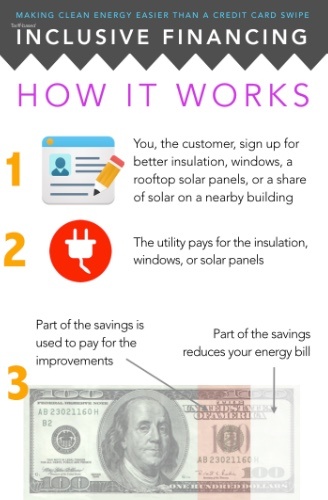 Incentives and Financing
Incentives and Financing
There are a range of incentives and financing tools for deploying charging infrastructure. State and federal incentives (the latter now expired) to subsidize at-home charger installations defray the cost for individuals, or could be passed directly to the utility to support greater deployment of public charging infrastructure. Some utilities offer rebates for chargers — the Los Angeles public utility, for example, offers a $500 rebate for a Level 2 charger and an additional $250 for those that install a second meter to access the time-of-use rate.
In California, property owners can tap into Property-Assessed Clean Energy (PACE) financing to pay for charging hardware and installation. In general, the program allows them to borrow funds for efficiency and renewable energy-focused upgrades, repaid through city-managed property tax assessments. Local governments in Florida, for example, have leeway to provide drivers with financing for eligible costs. Massachusetts, on the other hand, set aside grants to finance the equipment.
Utilities have also introduced tariff-based inclusive financing to pay the upfront cost of energy saving investments on private property, with costs recovered similar to how costs for power plants are recovered. This tool could similarly be used for electric vehicle chargers, given that the improvements in both cases provide a revenue stream for repayment — for efficiency or solar, from the improvement itself, and for chargers from electricity sales revenue increased by vehicle charging.
Role of Cities
Cities can lead on installation of public charging infrastructure, as a part of fleet transformation or emissions-reduction goals. For example, if cities adopt electric vehicles for fleet use, they can set up chargers that private drivers can access in the daytime, but are used for fleet vehicles at night. Cities can also work with utilities to ensure an equitable distribution of public charging infrastructure, to accommodate drivers who may not have access to off-street parking (or an at-home charger).
Los Angeles is a leader in charging station deployment, with 724 Level 2 charging stations and 16 DC fast charging stations available for public use (the latter available for free), in service of 13,000 vehicles, as of June 2015. The city expanded charging options through a multimillion-dollar rebate program that provides free equipment to residential and commercial properties.
Electric vehicle infrastructure can provide a springboard for cities to advance overarching clean energy goals. In 2012, St. Paul, MN, became one of the first U.S. cities to debut its own charging infrastructure. Two publicly accessible solar-powered chargers marked the beginning of a bigger network build-out, anchored in a park seen as a “regional destination” for electric vehicle drivers. Federal stimulus dollars covered about 60% of total project costs, while the city and utility Xcel Energy split the rest.
An Eye Toward Autonomy
Autonomous vehicles, typically using an electric drivetrain, present a potential complication for planning charging infrastructure. If these cars become ubiquitous, they may substantially alter vehicle ownership and use patterns. For example, if autonomous vehicles could be easily and inexpensively summoned on short notice, they could spur a sharp decrease in vehicle ownership, especially for households owning second (or third) cars. This shift would have substantial implications for charging infrastructure because instead of a large vehicle fleet that’s idle for over 90% of each day, we would have thousands of vehicles in near-constant use, requiring very fast refueling. Rather than heading to home garages with 6- to 8-kilowatt chargers, these vehicles might cluster at charging depots near utility substations, where they could access a charge at 100-kilowatts or more.
Tesla, the maker of the most highly touted battery-powered cars on the market, has said all of its vehicles will be equipped with hardware needed to enable self-driving technology. In addition, the company plans to roll out its own fleet of self-driving cars and a ride-hailing service, both under the banner of the Tesla Network. In particular, the ride-hailing element (similar to Uber and Lyft) would allow Tesla drivers to rent out their vehicles and capture a piece of the ride-hailing revenue. Through an app, Tesla owners could open their self-driving vehicles at any time to people seeking rides through the forthcoming network.
Unlike the existing Uber and Lyft models, Tesla owners would not need to actually drive their cars to pick up fares. In fact, they would not even need to be in them. The model potentially opens an ample value stream for vehicle owners to financially justify Tesla ownership.
Writing to Tesla owners in a “master plan” drafted in July 2016, Tesla CEO Elon Musk said, “You will be able to add your car to the Tesla shared fleet just by tapping a button on the Tesla phone app and have it generate income for you while you’re at work or on vacation, significantly offsetting and at times potentially exceeding the monthly loan or lease cost.”
Writing in Greentech Media, Tam Hunt tabulated the possible payoff for the owners of automated Teslas, based on the $15 average hourly income for a part-time Uber driver in Santa Barbara, CA. If a Tesla owner rented their vehicle on the Tesla Network at that hourly rate for 15 hours per week, they would see $225 in weekly income, or about $964 per month.
Even subtracting $80 per month in electricity and insurance costs, plus 35% in taxes, the monthly takeaway is $504. That narrowly outstrips monthly loan payments for a Tesla Model 3 priced at $27,500 (after a $7,500 federal tax credit), with $1,000 down and a five-year loan with a 5% interest rate. Under those circumstances, Hunt estimates the “cost” of ownership is a net positive $4 per month.
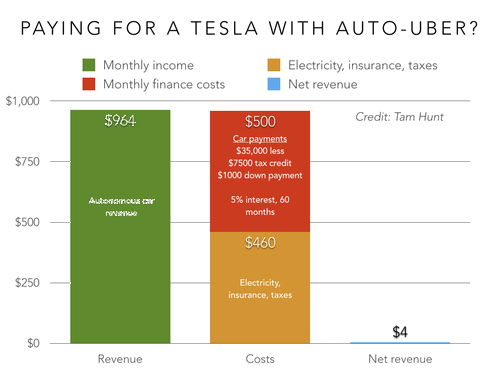
Following Hunt’s logic, and assuming regulators sign off on both the introduction of automated vehicles and Tesla’s rideshare plan, a driver with good enough credit to access favorable financing could essentially own their Tesla for free (minus a $1,000 down payment).
Will this model actually emerge? It’s unclear, but we acknowledge this complication in electric vehicle infrastructure planning and suggest policy makers remain flexible as the technology is commercially deployed.
 Providing Rates to Guide Charging
Providing Rates to Guide Charging
Low-cost charging rates represent the second major policy initiative for expanding electric vehicles. There’s ample evidence that utilities can use low rates to enhance grid benefits of, and customer savings from, electric vehicle charging.
Thus far, infrastructure has been a barrier.
In particular, utilities have required customers to make upfront investments in metering and charging hardware in order to access lucrative charging plans. Minnesota’s biggest power provider, Xcel Energy, provides access to lower vehicle charging rates only to customers who pay out of pocket for the installation of a second electric meter, which runs $500 to $1,500. The utility also collects from the customer a monthly $5 metering charge. As such, “only 20 EV owners out of an estimated 3,000 have signed up for the tariff,” according to comments filed with the state’s Public Utilities Commission in July 2016. Customers can instead select a standard time-of-use rate for all household use that provides an off-peak charging incentive, but that also means higher costs for daytime use of electricity for other purposes.
Pacific Gas & Electric (PG&E) offers a similar option. The installation of separate metering equipment for vehicle charging costs around $2,000, but allows customers to charge their electric car by itself on a time-of-use rate.
Other utilities provide more compelling incentives. In Maryland, PEPCO provides a time-of-use rate for electric vehicle charging and the utility pays for the required second meter.
Another Minnesota utility, Dakota Electric, identified a less expensive option. Its customers pay to install a sub-metered circuit rather than an entire second meter. This equipment typically costs between $70 and $110, with labor costs between $500 and $1,000, based on the location of the charging station and other factors, according to a utility employee. A rebate worth up to $500 helps offset some, but not necessarily all, of these expenses.
Utilities that want to capture the benefits of managed charging need to provide mechanisms, incentives, and financing that makes sense for customers. Utilities that have made managed charging possible do see benefits.
A Sacramento utility tested a pricing plan with three time-varying options, and found it shifted as much as 10% of its peak load to other periods. Sacramento’s Municipal Utility District has also offered a “charge free for a year” promotion, valued at $300 per vehicle, and provided public fast-charging stations.
The movement toward better charging policies is underway, albeit slow-moving. By June 2015, 28 utilities in 15 states had implemented tariffs that address electric vehicle charging. The measures can support power providers and reward drivers whose habits align with grid needs.
Minnesota, a major wind-producing state that in 2014 required its large utilities to add electric vehicle tariffs, has proven fertile testing ground for overnight charging incentives. According to the requirement, each utility designs its own electric vehicle tariff. Though each tariff is distinct, common elements include the required installation of new charging hardware and steep overnight charging discounts.
Tariffs for two of Minnesota’s largest electric utilities are shown in the chart below. As noted previously, Xcel Energy requires installation of a full second meter to access its electric vehicle rate while Dakota Electric offers a sub-metering option.

For utilities that lack off-peak charging rates, however, utility commissions or state legislatures should require their adoption given the widespread, proven benefits.
Charging from Utility or Self-Supplied Renewable Energy
As discussed previously, renewable energy and electric vehicles are a powerful match, because discretionary charging can cater to variable supply. In some parts of the country, overnight charging dovetails with better overnight wind energy production and in others parked electric vehicles can help absorb noon-time solar energy production.
Utilities are inconsistent in their approach to unlocking these potential benefits. Xcel Energy in Minnesota does not offer a discount for charging from renewable energy, but rather charges the same premium for its Windsource program to all users. In contrast, cooperative utility Great River Energy (also in Minnesota) offers wind fueling at no extra charge.
Minnesota cooperative utility Great River Energy offers wind fueling at no extra charge. The utility also plans to implement incentives for customers charging infrastructure, and help electrify schools buses.
The availability of midday charging options also helps alleviate range concerns. In a rollout of public charging stations, San Diego Gas & Electric Co. will provide special rates that reward drivers who plug in when renewable energy generation is most abundant. Marin Clean Energy, also in California, offers a rewards program for customers who plug in during afternoon hours. In another sun-rich state, the Hawaiian Electric Companies in 2015 unveiled rates that are lowest between 9 a.m. and 4 p.m., when solar production is highest.
Utility pricing plans can also encourage on-site use of solar.
A Hawaiian Electric Company program launched in summer 2016 makes solar charging a logical option for electric vehicle owners who can charge at home during daylight hours. Born of a transition away from net metering, customers with solar have two choices: provide excess power to the grid and receive credits worth about half the retail price for electricity, or retain all of their solar electricity for on-site use. Customers using the “self supply” option cannot feed power back onto the grid, though they can capture the full value of their solar electricity (by offsetting electricity that otherwise costs $0.25 to $0.35 per kilowatt-hour) instead of selling it to the utility at about half that price.
The program aligns with 2015 findings from the Rocky Mountain Institute that together with batteries and smart appliances designed to help households better manage energy, electric vehicles could drive a 50% to 90% increase in on-site solar consumption.
In New York, a reworked algorithm for the value of distributed solar sets up a system that also favors greater on-site electricity use, such as charging an electric vehicle. The “transparent pricing” structure values distributed energy based on its location, plus its benefits to the grid and the environment. The adjusted calculus is part of a transition away from traditional net metering.
No matter what, New York households with solar will net less revenue than they would have with net metering, but assuming the “transparent price” will be lower than the retail net metering credit, households that use more of their distributed generation on site will squeeze more value from their arrays.
Assuming two Empire State families each have a 5-kilowatt solar array that produces 7,000 kilowatt-hours per year, the relative costs and benefits vary, as illustrated below. In both cases, we assume that net metering provides $0.18 per kilowatt-hour in compensation, while the “transparent price” is just $0.14.
If one family uses just 30% of the electricity it generates and sends the rest to the grid, the new system would not deliver as much value as the longstanding net metering framework that paid full retail value for the generation. That means if the other family uses 70% of its electricity on site, it preserves more value. Charging electric vehicles at home is one way to significantly boost on-site usage.
In the long run, utilities should work in partnership with charger manufacturers and automakers to allow vehicle charging to follow renewable energy supply. More immediately, utilities should offer financial incentives (in the form of price discounts) to customers that encourage vehicle charging when there’s ample supply of renewable energy.
Deliberate Resource Planning
Utilities typically produce 15-year or longer “resource plans” to map out additions of new power plants and power lines that will last for decades. This is their “planning horizon.” But electric vehicles may have an impact much sooner than the 40-year lifetime of these traditional resources, or even the 15-year timeframe of resources plans. In other words, the timing of electric vehicle policy is as important as the magnitude of vehicle adoption, and the rising numbers of electric cars on U.S. roads may impact utility plans well within their current planning horizon.
At least one utility, the Sacramento Municipal Utility District, is already laying the groundwork in its planning, which includes:
- Modeling potential vehicle adoption
- Planning and deploying public charging infrastructure
- Providing incentives for electric vehicle adoption
- Advertising and conducting outreach to customers about electric vehicles
- Expanding the utility’s fleet of electrified light- and heavy-duty vehicles
- Supporting electrification of public fleets, such as school buses
- Researching charging controls
In most states, Public Utilities Commissions will play a crucial role, as they oversee utility resource plans. Minnesota’s Commission, for example, opened a docket to explore distribution-level resource planning. California regulators launched a rulemaking process in 2014 to implement a new law requiring distribution-level planning. It’s an ongoing proceeding, but already requires utilities to provide a public “hosting capacity” analysis of their distribution grids to determine where distributed energy systems could readily leverage existing capacity.
Increasing Access to Electric Vehicle Ownership and Benefits
As electric vehicle adoption grows, there’s an issue of allowing people who do not own a vehicle or for whom the cost premium is prohibitive to enjoy the benefits. This can include means-tested incentives for purchasing vehicles, public charging infrastructure near multi-family housing, and electrifying car-sharing and public transit fleets.
Before considering targeted policies, it’s worth noting that electric vehicles have every hallmark of technology diffusion like computers or smartphones. In other words, early adopters tend to be wealthy, but the increasing production driven by these first movers lowers the price for new entrants. The following two charts illustrate this dynamic for smartphones, where ownership has more than doubled in five years while costs — of non-Apple devices — have dropped by nearly half.
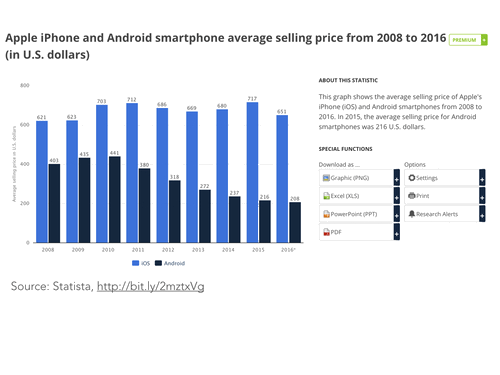
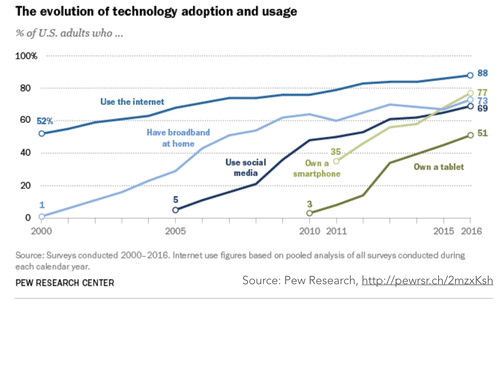
Electric vehicles can save their owners money through reduced fuel and maintenance costs — and by potentially helping to balance the grid during peak demand times — but new electric cars still require a substantial upfront investment. The average new electric car costs $36,000, although that can be reduced with the $7,500 federal tax credit. The secondhand market may already provide opportunities, however, with two-year old Nissan Leafs selling for under $15,000.
Pioneering legislation at the state level, most notably in California, has begun to expand the field of prospective new electric vehicle owners. In late 2016, the state’s Clean Vehicle Rebate Project increased benefits available for lower-income households and excluded high-income earners — households with income exceeding $300,000, who had been capturing most of the program’s benefits. The changes allow eligible households to claim $2,500 for buying or leasing a battery-powered vehicle, or $1,500 for choosing a plug-in hybrid. For lower-income households — a family of four earning less than $73,000 per year — the rebate amounts increase by $2,000.
Even with means-tested incentives, electric vehicle owners need access to charging infrastructure. GIven that lower-income users disproportionately lack a private garage or carport for charging, public chargers near multi-family dwellings are particularly important. In California, several investor-owned utility charging infrastructure programs set minimum targets for deployment in low-income areas. San Diego Gas & Electric Co. plans to install 3,500 total public chargers and place 10 percent of them in disadvantaged communities.
There are additional ways to provide the benefits of vehicle electrification, even to households that can’t afford or don’t require a vehicle. Encouraging electric vehicle use in car sharing programs, for example, can provide access to those who don’t own a vehicle. The City of Los Angeles is using funds from California’s cap-and-trade program to finance an electric car-sharing program catering to low-income communities. A similar program will provide eight electric vehicles near subsidized housing projects in Sacramento.
Electrification of public transit can save transit agencies money while benefiting communities that carry a disproportionate share of the health and environmental costs of diesel emissions. The newest Proterra E2 electric bus, for example, costs $250,000 to $300,000 more than a comparable diesel bus, but cut $275,000 in fuel costs and $400,000 in maintenance costs over its lifetime (other estimates show the savings for the latter closer to $160,000, which is still a 30-40% savings over a diesel bus).
Electrifying bus fleets also substantially reduces air pollution, including the particulate matter that contributes to respiratory illnesses, heart disease, and other conditions. A Columbia University analysis published in 2016 for New York City Transit estimates that a full diesel-to-electric transition for that city’s 5,700 buses would reduce particulate matter emissions by 97.5%, assuming each bus travels 27,600 miles per year and uses roughly 10,000 gallons of fuel.

Factoring in costs associated with hospitalization, emergency room visits, and absences from work, the health benefits of the diesel-to-electric switch deliver annual cost savings worth about $150,000 per bus, a total of over $850 million. Each zero-emission bus also eliminates 1,690 tons of carbon dioxide over its average 12-year lifespan — the equivalent of removing 27 cars from the road, according to U.S. Department of Transportation figures.
Promoting Vehicle-to-Grid
There are several major challenges to broader adoption of vehicle-to-grid technology: lacking industry standards for software and hardware, market rules and tariffs, infrastructure, friendlier vehicle warranties, and cyber-security. This section will detail the roadblocks, but with the caveat that electric vehicles offer substantial opportunities even without vehicle-to-grid availability. (More on vehicle-to-grid technology is in Appendix A).
Fundamentally, the technology is caught in a problematic loop: manufacturers don’t build compatible features into their electric vehicles because there isn’t yet a market for them, but there isn’t a market because the features aren’t yet available. German automaker Daimler Mercedes-Benz has installed related software in its electric vehicles, for example, enabling them to control charging in a way that helps balance the grid. But until German utilities integrate the technology into their grids, it cannot achieve its potential. A standard adoption agreement between utilities and carmakers is likely necessary to jumpstart implementation. Such a pact would require parties on both sides to incorporate the technology into their suite of offerings within a given timeframe.
Cooperation between auto manufacturers and regulators is also needed. As it stands, car manufacturers largely do not allow vehicle-to-grid use under their warranties. Given limited experience with electric vehicle batteries, few consumers would be willing to test money-making opportunities on the grid if it risks coverage of their primary mode of transportation.
Market regulations need to better accommodate mobile power-delivery and storage resources, lowering limits for participation or making it easier to bundle electric vehicles to be a viable source of ancillary services for utilities. In PJM’s Eastern regional grid territory, for example, market participants only need 100 kilowatts of capacity, energy, or ancillary services. In MISO’s Midwest territory, on the other hand, there isn’t even a market yet.
In 2016, CAISO evolved its requirements to better match a more diverse, and increasingly distributed, energy mix. Where it had previously set a 500-kilowatt threshold for wholesale power market participation, it won approval for a new framework that allows smaller distributed energy resources to bundle together to meet that threshold. The New York Independent System Operator (NYISO) allows for similar aggregation to reach a 1,000-kilowatt minimum threshold for participation in its demand response programs.
Specially designed tariffs would help grow and maintain the electric vehicle market, especially considering that a V2G model encourages drivers to plug in their vehicles often to make them available to provide grid services.
Charging infrastructure must be accessible at homes and offices, so vehicles are consistently available when the grid operator needs them. There are relatively few chargers in either place yet, and almost none equipped for two-way services. This infrastructure also needs the capability to exchange regular and frequent data with the grid about its needs.
Cybersecurity protection for drivers and grid, who would share data, is also necessary. As vehicles become increasingly networked, they also grow more vulnerable. Until now, connectivity features now commonly installed in vehicles — from remote diagnostics to GPS — have invited little interference outside controlled experiments on willing participants. But the specter of unplanned breaches, particularly as the marketplace relies more on shared wireless technology, prompted Congressional action in 2015 to establish federal safety standards to protect privacy and safety.
Unlocking vehicle-to-grid as a regulation and storage resource will not impose significant technological challenges on the existing grid, though it will require the aggregation of hundreds or thousands of vehicles in a given area in order to create a sizable enough power source to capture utility and grid operator interest. Regulators can help create this market by working with utilities and carmakers to get the rules and the infrastructure in place.
Summary of Recommended Policies
Infrastructure
- Utilities should finance private chargers and invest in public charging networks based on future revenue from sales of electricity to power vehicles (and/or implement inclusive, tariff-based on-bill financing). Regulators should ensure choice and competition in charging hardware for private and public chargers.
- Public charging infrastructure should be well distributed geographically and equitably, especially in areas where private parking and charging is less available, such as near multi-family housing and business districts.
- Cities should allow residents and businesses to use Property Assessed Clean Energy (PACE) financing for electric vehicle charging hardware, and also lead by example by electrifying fleet vehicles and providing public access to fleet charging stations.
Charging
- Utilities should offer charging plans that include substantial discounts for charging during off-peak hours or absorbing excess renewable energy supply.
- Utilities should lower barriers (such as hardware and installation costs) to accessing discounted charging programs.
- Utilities, charger manufacturers, and automakers should harmonize technology to allow for vehicle charging to follow and accommodate renewable energy supply.
- Cities should work with utilities and car dealers to offer bundled solar and electric vehicle purchases, and deploy policies to support on-site charging from solar.
Incentives and Access
- Electric vehicle incentives should be means-tested.
- Car-sharing and transit systems should be electrified due to widespread health and environmental benefits.
Conclusion
Electric vehicles represent a titanic shift in the transportation sector, a back-to-the-future moment where battery-powered vehicles can reclaim the position of most popular drivetrain. Their adoption has many significant implications, from the decarbonization of transportation by enhancing renewable electricity use, to widespread opportunities to improve electric grid efficiency with distributed energy storage.
Electric cars also spark energy democracy, aiding the adoption of greater local renewable energy production and miniaturizing electricity grids by giving communities control over their power when the larger grid is up or goes down. The increase in local authority and power generation from electric vehicle deployment will charge local economies along with their vehicle fleet.
The most important lesson is that doing nothing — especially in the near term — will inflict minimal harm from the perspective of grid operations and costs. Given common charging practices and limited numbers, electric vehicles won’t substantially impact the electricity system for several years.
Still, we stand at an inflection point.
The electric vehicle is like a wheeled shipping container of disruptive technology. Its electric drivetrain is incredibly efficient, requires much less maintenance, and lasts much longer than an internal combustion engine. It can fuel for as little as one-tenth the cost of a gasoline vehicle per mile. It can provide other functions, including backup power to the owner’s home and ancillary grid services. And its only high-cost component, batteries, are falling in price rapidly as production accelerates.
Given these features, electric vehicle adoption is likely to follow the technology adoption “S curve,” reinforced by a variety of technologies (and shown below).
With exponential growth likely ahead and utility planning horizons extending 15 to 40 years, the time to adopt the right policies is now.
In order for communities to fully capture the benefits electric vehicles can deliver, regulators and utilities across the U.S. need to begin rolling out policies and programming to promote electric vehicle ownership, incentivize charging at times that make sense, build up necessary charging infrastructure, and set standards for vehicle-to-grid connections.
With exponential growth likely ahead, the time to adopt the right policies is now.
In particular, to capture the energy democracy opportunity, we need universal accessibility to electric vehicle benefits. We need policies like inclusive financing to provide both public and private charging infrastructure. We need to electrify public and private fleets to widely share the localized environmental and health benefits of switching from oil to electricity. We need charging policies that lower the cost to charge as electric vehicles lower the cost of grid operations. We need charging policies that amplify local benefits, such as maximizing local solar generation. We need incentives that allow people at many income levels to participate.
Electric vehicles will upend the transportation system — and soon — and provide new ways for communities to take charge of their energy future. With appropriate planning, communities across the country can parlay the proliferation of electric vehicles into a cornerstone of a local energy economy.
[RETURN TO TOP]
Appendix A – The Vehicle-to-Grid Future
Maximizing the value of electric vehicles to the grid means turning one-way charging into a two-way flow of electricity, taking advantage of the average vehicle sitting idle for 23 hours per day. Unfortunately, most vehicle-to-grid (V2G) technology remains closer to a pilot concept than commercial reality.
It’s a chicken-and-egg problem. Auto manufacturers do not equip existing electric vehicles with the technology to deliver power back to the grid because of a lack of standards, and there are few standard utility interfaces or markets for electric vehicle services because so few vehicles have the capability.
In this section, we detail the opportunity for electric vehicles to serve the grid if the technology and standards barriers can be overcome.
Fast Response to Grid Needs
Electric vehicles with two-way capabilities could pump electricity back onto the grid during times of peak need or provide ancillary services more powerful than by charging alone.
A properly-equipped electric vehicle can respond to grid needs much faster than traditional power generation. This relatively quick “ramp rate” — the speed at which they can increase or decrease generation — means V2G-equipped vehicles could be a powerful contributor to a more nimble, responsive grid. The fast-response (typically gas-powered) plants currently used to answer demand jumps can ramp up quickly, but carry high operating costs. A vehicle, on the other hand, can provide these services “on the side” of its primary function as a transportation tool. The following chart illustrates how today’s vehicles can provide grid services by varying their level of charge, but how a vehicle-to-grid equipped car could provide twice the level of service.
Beyond grid benefits, these vehicle-to-grid capabilities increase the value of electric vehicle ownership. When an electric car can play in the energy regulation market, it can deliver value of more than $100 per kilowatt simply by charging and discharging power. A federal study found that if they could participate in frequency regulation alone, electric vehicle owners in Southern California could shave 72% from their monthly lease costs, even if the vehicle was being used during normal business hours. The caveat is that the test involved significant, though shallow, cycling of the battery: 61,000 cycles tapping about 2% of its capacity. This compares to just 240 cycles for refueling the vehicle (assuming a need for 50% charge). Assuming than 100 cycles at 2% are the same as 2 cycles to 100%, the ancillary services use would put 10 times more wear on the battery than driving.
Selling frequency regulation services to the grid could allow electric car owners in California to cut their lease costs by 72%!
Services to Buildings
Properly equipped electric vehicles could provide power and services to buildings, not just the grid. Many commercial electricity customers, for example, have “demand charges” based on the maximum amount of energy used in a 15-minute time interval each month. Plug-in hybrid and all-electric vehicles could reduce demand charges for building owners.
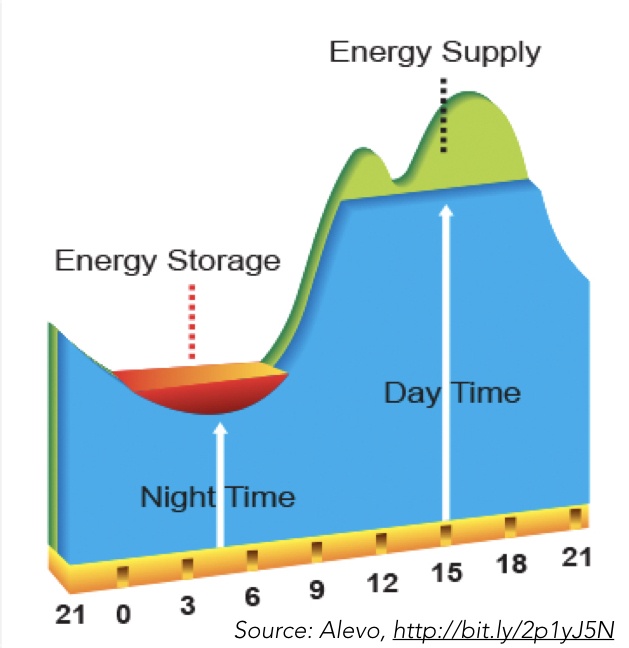 According to a study examining a fleet of ten plug-in hybrids serving the Massachusetts Institute of Technology (MIT) in Boston, the monthly savings of tapping car batteries to shave off short-duration periods of high demand totaled $158 per vehicle. Modeling that reflects wear and tear on batteries used in this vehicle-to-building scenario shows that a vehicle engaging in seven transactions per month incurs less than $7 in added battery replacement cost during that span — well below the $158 in potential monthly benefits from the process. The depth of charge required for peak shaving (up to 80%) was much higher than for ancillary services (about 2%). However, the cars modeled had batteries with just 9 kilowatt-hours of capacity each, about a third of what an all-electric Nissan Leaf is currently equipped with.
According to a study examining a fleet of ten plug-in hybrids serving the Massachusetts Institute of Technology (MIT) in Boston, the monthly savings of tapping car batteries to shave off short-duration periods of high demand totaled $158 per vehicle. Modeling that reflects wear and tear on batteries used in this vehicle-to-building scenario shows that a vehicle engaging in seven transactions per month incurs less than $7 in added battery replacement cost during that span — well below the $158 in potential monthly benefits from the process. The depth of charge required for peak shaving (up to 80%) was much higher than for ancillary services (about 2%). However, the cars modeled had batteries with just 9 kilowatt-hours of capacity each, about a third of what an all-electric Nissan Leaf is currently equipped with.
The bulk of vehicle-to-building pilot programs focus on microgrid and smart grid integration, scaled to hundreds of vehicles rather than the thousands needed to have a meaningful impact on the overall grid. Enterprising one-off projects showcase the technology’s potential. Much like the cars in the MIT study, Nissan equipped the parking area at one of its Japanese facilities to link with six Nissan Leafs, tapping into their battery power at peak demand times to avoid peak charges.
Nissan reported in 2013 that its pilot had allowed the facility to reduce its energy use during periods of peak summertime demand by controlling the charging time of the vehicles — all with virtually no impact on their owners’ daily commutes or on the vehicles themselves. The program cut electricity use at the site by 2.5 percent during peak hours, saving roughly $4,500 (based on 2013 currency values).
The opportunity in vehicle-to-building services is one of complementary benefits: building owners can reduce their electric charges and vehicle owners can reduce the cost of ownership, if cost savings are shared.
Electric Vehicles as Bulk Storage
Energy storage is frequently held up as the holy grail of integrating high levels of renewable energy into grids. Mass adoption could provide enormous opportunity for dual use of electric vehicles: as cleaner transportation and — with appropriate vehicle-to-grid technology — as backup to solar and wind power on the grid.
Of all places in the United States, Hawaii offers the most compelling look at how energy storage can serve the grid, and how electric vehicles could meet the need. Every drop of oil is imported by ship, serving most vehicles but also two-thirds of electric generation. Its electricity costs are among the highest in the country, nearly three times the U.S. average. But as island grids, Hawaii also must manage its electricity supply and demand without aid of neighbors. Katherine McKenzie of the Hawaii Natural Energy Institute, a co-author of the 2016 study examining electric cars’ impact on Oahu, said the island likely won’t pass far beyond the 40 percent threshold for producing electricity with renewables unless electric vehicles play a role in reducing curtailment.
The state is already nearing this threshold. Over 15% of households now sport a solar array — a vital component of the state’s mission to generate 100 percent of its electricity using clean energy sources by 2045. In 2015, renewables including wind and solar provided 17% of electricity for Oahu, 35% on Maui, 49% on Hawaii Island, and nearly 40% for Kauai.
In 2014, the utility companies announced plans for a project that would add 60 to 200 megawatts of storage capacity, specifically to manage solar and wind power. The Hawaiian Electric Companies, which provide power to most residents of the state, have 17 storage projects planned or underway as of November 2016. ILSR’s report on Hawai’i at the Energy Crossroads highlights the challenge and opportunity.
Electric vehicles could also potentially supply significant storage. The largest of three utility-led projects planned on Oahu will add 45 megawatt-hours of electricity storage, enough to power over 2,000 homes for an entire day. Assuming the average electric car battery holds 30 kilowatt-hours, 1,500 electric vehicles could provide the same supply — if they were plugged in round the clock and could be emptied in service of the grid. Assuming more realistic limits, such as limiting battery drain to 10% and that approximately 25% of vehicles would be unavailable at any hour, it would take only about 20,000 vehicles to provide the same level of energy storage as a utility-scale battery.
Projections suggest the mass adoption of electric vehicles is imminent in Hawaii. Buoyed by Oahu, Hawaii saw the number of registered plug-in vehicles jump 46 percent year over year to 3,243 in January 2015, and to over 4,000 in January 2016. An explicitly conservative forecast predicted Hawaii would boast 110,000 electric vehicles by 2040, with high-end estimates reaching 280,000.
With plug-in cars representing 10-20% of the islands’ vehicle fleet, they could provide several times more energy storage than the largest planned project, or between 300 and 760 megawatt-hours of potential storage, each day. That’s 1.3 to 3.2% of the average daily electricity use of the entire state, and from sources that also provide emission-free transportation. Put another way, using 6.6 kW Level 2 chargers, the vehicles could supply as much capacity (700 to 1,800 megawatts) as a full size power plant.
Two competing factors could influence the number of available electric vehicle to absorb renewable energy production. One limiting factor is the economics. With higher than average electricity prices, the cost of driving an electric mile in Hawaii can be higher than driving on gasoline. However, this will likely change dramatically as the reliance on oil for electricity generation falls with the switch to fuel-free renewables.
A favorable factor is the dramatically improving economics of electric vehicles. Author of Clean Disruption Tony Seba notes that battery prices — the driving force in electric vehicle sticker prices — fall exponentially as their production dramatically ramps up. As such, electric vehicles are likely to prove more competitive than gasoline vehicles in a shorter timeframe than imagined, making available more potential energy storage. There’s also the potential to re-use batteries from retired electric vehicles. Additionally, driving distances are limited by geography on most Hawai’ian islands, reducing the range barrier for many 1st generation electric cars.
Providing grid services, building services, or bulk storage is an exciting possibility, but it will take significant development of technology and standards before we see significant commercialization of vehicle-to-grid technology.
[RETURN TO TOP]
Appendix B – Electric Bus Savings
Upfront cost difference
An electric bus costs $750,000 compared to $450,000-500,000 for a diesel bus. We’ll use a difference of $300,000 to be more conservative.
Fuel cost difference
Lifetime fuel costs for average mileage of 500,000 would be $375,000 for a diesel bus. (500,000 miles, 4 miles per gallon, $3.00 per gallon). Lifetime fuel costs for 500,000 miles in an electric bus would be based on on average of 272 miles per charge, with an average charge of about 550 kilowatt-hours. So the 1838 full charges required in its lifetime times 550 kilowatt-hours would be just over 1 million kilowatt-hours. At an off-peak charging rate of $0.03 per kilowatt-hour, the lifetime fuel costs for the electric bus are $30,000. So the fuel savings of an electric bus are $345,000, greater than the price difference between to two bus technologies.
[RETURN TO TOP]
Appendix C – Driving Electric Savings
[RETURN TO TOP]Sources
Introduction
- U.S. Census Bureau. “Electrical Apparatus and Supplies.” 1900. https://www2.census.gov/prod2/decennial/documents/05457254v10ch2.pdf
- U.S. Department of Energy. “The History of the Electric Car.” September 2014. https://energy.gov/articles/history-electric-car
- Pacific Standard. “Steam-Powered Cars: California’s 1970s Smog Solution.” February 2013. https://psmag.com/environment/hybrid-cars-steam-smog-52567
- Wired. “Ford, Edison and the Cheap EV That Almost Was.” June 2010. https://www.wired.com/2010/06/henry-ford-thomas-edison-ev/
- San Francisco Chronicle. “Owners charged up over electric cars, but manufacturers have pulled the plug.” April 2005. http://www.sfgate.com/green/article/Owners-charged-up-over-electric-cars-but-2677780.php
- Salon. “Electric cars are coming!” May 2009. http://www.salon.com/2009/05/20/electric_cars_2/
- Curtis Darrel Anderson and Judy Anderson. “Electric and Hybrid Cars: A History.” 2005. https://books.google.com/books?id=vfZceT8LpYoC&printsec=frontcover&source=gbs_ge_summary_r&cad=0#v=onepage&q&f=false
- Rocky Mountain Institute. “Electric Vehicles as Distributed Energy Resources.” 2016. https://www.rmi.org/insights/reports/electric-vehicles-distributed-energy-resources/
- U.S. Energy Information Administration. “Frequently Asked Questions.” October 2016. https://www.eia.gov/tools/faqs/faq.php?id=97&t=3
- Institute for Local Self-Reliance. “Energy Democracy in 4 Powerful Steps.” March 2017. https://ilsr.org/energy-democracy-in-4-steps/
Electric Vehicles Going Mainstream
- Inside EVs. “Monthly Plug-In Sales Scorecard.” 2017. http://insideevs.com/monthly-plug-in-sales-scorecard/
- Sierra Club. “New Data Shows Auto Industry Failing to Advertise Electric Cars.” December 2016. http://www.sierraclub.org/compass/2016/12/new-data-shows-auto-industry-failing-advertise-electric-cars
- Bloomberg New Energy Finance. “Electric vehicles to be 35% of global new car sales by 2040.” February 2016. https://about.bnef.com/blog/electric-vehicles-to-be-35-of-global-new-car-sales-by-2040/
An Innovation Hotspot
- Rocky Mountain Institute. “EVs Charge Ahead with New Technologies and Business Models.” June 2016. https://rmi.org/news/evs-charge-ahead-new-technologies-business-models/
- Barrons. “Apple R&D Way More Than Detroit, Says Morgan Stanley; Big Cloud Spending?” May 2016. http://www.barrons.com/articles/apple-r-d-way-more-than-detroit-says-morgan-stanley-big-cloud-spending-1464205850
- The Wall Street Journal. “Apple Targets Electric-Car Shipping Date for 2019.” September 2015. https://www.wsj.com/articles/apple-speeds-up-electric-car-work-1442857105
Range Concerns Diminishing
- Federal Highway Administration. “Electric Vehicle Feasibility.” July 2016. http://nhts.ornl.gov/briefs/EVFeasibility20160701.pdf
- Los Angeles Times. “Can the 2017 Chevy Bolt really go 200-plus miles with no recharge? We try it.” September 2016. http://www.latimes.com/business/autos/la-fi-hy-bolt-ev-drive-20160912-snap-story.html
- Vox. “The electric cars available today, how much they cost, and how far they go — in one chart.” September 2016. https://www.vox.com/energy-and-environment/2016/9/23/13018294/electric-cars-price-range-one-chart
Falling Cost of Ownership
Better Battery Prices Make Electric Cars Competitive
- Nature. “Rapidly falling costs of battery packs for electric vehicles.” March 2015. https://www.nature.com/articles/nclimate2564.epdf?
- Bloomberg. “Here’s How Electric Cars Will Cause the Next Oil Crisis.” February 2016. https://www.bloomberg.com/features/2016-ev-oil-crisis/
- E&E News. “Incentives for energy storage spread worldwide.” March 2014. https://www.eenews.net/energywire/stories/1059996345
- Bloomberg. “The Electric Car Revolution Now Faces Its Biggest Test.” April 2017. https://www.bloomberg.com/news/articles/2017-04-24/the-electric-car-revolution-tesla-began-faces-its-biggest-test
Tesla’s Supercharged Role
- MIT Technology Review. “How Tesla is Driving Electric Car Innovation.” August 2013. https://www.technologyreview.com/s/516961/how-tesla-is-driving-electric-car-innovation/
- Tesla. “Tesla Gigafactory.” 2017. https://www.tesla.com/gigafactory
- MIT Technology Review. “Why We Don’t Have Battery Breakthroughs.” February 2015. https://www.technologyreview.com/s/534866/why-we-dont-have-battery-breakthroughs/
- CleanTechnica. “7 Models = 81% Of Electric Car Sales In US (2016 US Electric Car Sales Report).” January 2017. https://cleantechnica.com/2017/01/06/7-models-81-electric-car-sales-us-us-electric-car-sales-report/
- Statista. “Tesla – Statistics & Facts.” 2017. https://www.statista.com/topics/2086/tesla/
Sticker Price v. Cost of Ownership
- Bloomberg New Energy Finance. “Electric vehicles to be 35% of global new car sales by 2040.” February 2016. https://about.bnef.com/blog/electric-vehicles-to-be-35-of-global-new-car-sales-by-2040/
- International Energy Agency. “Global EV Outlook: Understanding the Electric Vehicle Landscape to 2020.” April 2013. https://www.iea.org/publications/freepublications/publication/GlobalEVOutlook_2013.pdf
- Nature. “Rapidly falling costs of battery packs for electric vehicles.” March 2015. https://www.nature.com/articles/nclimate2564.epdf?
- Tony Seba. “Clean Disruption – Why Energy & Transportation will be Obsolete by 2030 – Oslo, March 2016.” March 2016. https://www.youtube.com/watch?v=Kxryv2XrnqM
- Edmunds. “2017 Nissan Leaf True Cost to Own.” 2017. https://www.edmunds.com/nissan/leaf/2017/st-401695947/cost-to-own/?zip=55407
- Edmunds. “2017 Nissan Versa True Cost to Own.” 2017. https://www.edmunds.com/nissan/versa/2017/st-401667379/cost-to-own/
- YourMechanic. “How Much Do Car Maintenance Costs Increase with Mileage?” July 2016. https://www.yourmechanic.com/article/how-much-do-maintenance-costs-increase-by-mileage-by-maddy-martin
- Nissan. “2016 Service and Maintenance Guide.” 2016. https://owners.nissanusa.com/content/techpub/common/2016/2016-nissan-service-maintenance-guide.pdf
- Nissan. “2015 LEAF Service and Maintenance Guide.” 2015. https://owners.nissanusa.com/content/techpub/ManualsAndGuides/LEAF/2015/2015-LEAF-service-maintenance-guide.pdf
- Inside EVs. “Battery Capacity Loss Warranty Chart For 2016 30kWh Nissan LEAF.” 2016. http://insideevs.com/battery-capacity-loss-chart-2016-30-kwh-nissan-leaf/
Policy and Pride at Play
Policy Aids
- Green Car Reports. “Will GM or Tesla buyers lose electric-car tax credits first?” February 2017. http://www.greencarreports.com/news/1109037_will-gm-or-tesla-buyers-lose-electric-car-tax-credits-first
- The International Council on Clean Transportation. “Evaluation of State-Level U.S. Electric Vehicle Incentives.” October 2014. http://www.theicct.org/sites/default/files/publications/ICCT_state-EV-incentives_20141030.pdf
- University of California-Davis Institute of Transportation Studies. “Exploring the Impact of High Occupancy Vehicle (HOV) Lane Access on Plug-in Vehicle Sales and Usage in California.” October 2014. https://itspubs.ucdavis.edu/wp-content/themes/ucdavis/pubs/download_pdf.php?id=2355
- Electric Power Research Institute. “Transportation Electrification: The PEV Market, Environmental Impact, and Future Technology.” October 2016. http://docketpublic.energy.ca.gov/PublicDocuments/16-TRAN-01/TN213900_20161005T090943_Presentation__Transportation_Electrification_The_PEV_Market_Env.pdf
‘Conspicuous Conservation’ or Sex Appeal
- Toyota. “Toyota Sells One-Millionth Prius in the U.S.” http://pressroom.toyota.com/article_display.cfm?article_id=2959&view_id=31907
- Steven E. Sexton and Alison L. Sexton. “Conspicuous Conservation: The Prius Effect and Willingness to Pay for Environmental Bona Fides.” April 2011. http://are.berkeley.edu/fields/erep/seminar/s2011/Prius_Effect_V1.5.3.pdf
- Reuters. “Tesla CEO Musk: almost 400,000 orders received for new Model 3.” April 2016. http://www.reuters.com/article/us-tesla-model-idUSKCN0XI0NR
- TheStreet. “Jefferies Raises Tesla Target to $360 Following Survey of Owners.” June 2015. https://www.thestreet.com/story/13198882/1/jefferies-raises-tesla-target-to-360-following-survey-of-owners.html
- Automotive News. “Tesla dominates consumer satisfaction survey, Consumer Reports says.” December 2016. http://www.autonews.com/article/20161222/RETAIL03/161229935/tesla-dominates-owner-satisfaction-survey-consumer-reports-says
- Tesla. “New Model S Now the Quickest Production Car in the World.” August 2016. https://www.tesla.com/blog/new-tesla-model-s-now-quickest-production-car-world
- Bloomberg. “Tesla ‘Easter Egg’ Makes the World’s Fastest Car Even Faster.” November 2016. https://www.bloomberg.com/news/articles/2016-11-16/tesla-easter-egg-makes-the-world-s-fastest-car-even-faster
- National Highway Traffic Safety Administration. “2013 Tesla Model S.” 2013. https://www.nhtsa.gov/vehicle/2013/TESLA/MODEL%252520S/5%252520HB/RWD
- Bloomberg. “Tesla’s Model S Falls Short of Top Safety Rating Awarded to 42 Other Cars.” January 2017. https://www.bloomberg.com/news/articles/2017-02-01/tesla-falls-short-of-top-safety-pick-awarded-to-42-other-cars
- Inside EVs. “Consumer Reports: Tesla Model S Rated #1 In Customer Satisfaction.” 2015. http://insideevs.com/consumer-reports-tesla-model-s-rated-1-in-customer-satisfaction/#comments
Leading by Example with EV Fleets
- SMUD. “SMUD Plug-in Electric Vehicles Integrated Resource Plan Inclusion.” October 2016. http://docketpublic.energy.ca.gov/PublicDocuments/16-TRAN-01/TN213892_20161004T132807_Presentation_%E2%80%93_Revised_SMUD_Plugin_Electric_Vehicles_Integrated.pdf
- New York State. “Governor Cuomo Announces $3 Million for Municipalities and Electric Cooperatives to Purchase Electric Vehicles.” February 2017. https://www.governor.ny.gov/news/governor-cuomo-announces-3-million-municipalities-and-electricity-cooperatives-purchase
- The City of New York. “ONENYC: Mayor Announces City Electric Vehicle Fleet Ahead of Schedule Half Way Toward Goal.” April 2017. http://www1.nyc.gov/office-of-the-mayor/news/245-17/onenyc-mayor-city-electric-vehicle-fleet-ahead-schedule-half-way-toward-goal
- Electrification Coalition. “The City of Houston: Forward Thinking on Electrification.” 2013. http://www.greenhoustontx.gov/ev/Houston_Case_Study_2013.pdf
Impact: Improving the Grid
- Navigant Research. “Plug-In Vehicles: For Utilities, More Opportunities than Challenges.” January 2014. http://www.navigantresearch.com/blog/plug-in-vehicles-for-utilities-more-opportunities-than-challenges
- U.S. Energy Information Administration. “Short-Term Energy Outlook.” May 2017. https://www.eia.gov/outlooks/steo/pdf/steo_full.pdf
- Rocky Mountain Institute. “It’s Time to Plan for Electric Vehicles on the Grid.” June 2016. https://www.rmi.org/news/time-plan-electric-vehicles-grid/
- Energy and Environmental Economics, Inc. “California Transportation Electrification Assessment.” October 2014. http://www.caletc.com/wp-content/uploads/2016/08/CalETC_TEA_Phase_2_Final_10-23-14.pdf
- Smart Electric Power Alliance. “Beyond load growth: The EV managed charging opportunity for utilities.” March 2017. https://sepapower.org/knowledge/beyond-load-growth-ev-managed-charging-opportunity-utilities/
- M.J. Bradley & Associates. “MJB&A Analyzes State-Wide Costs and Benefits of Plug-in Vehicles in Five Northeast and Mid-Atlantic States.” February 2017. http://www.mjbradley.com/reports/mjba-analyzes-state-wide-costs-and-benefits-plug-vehicles-five-northeast-and-mid-atlantic
EV Charging Terminology
- FleetCarma. “Plugging in Fleet Vehicles.” January 2013. https://www.slideshare.net/fleetcarma/plugging-in-fleet-vehicles
Managing Demand
- Rocky Mountain Institute. “Electric Vehicles as Distributed Energy Resources.” 2016. https://www.rmi.org/insights/reports/electric-vehicles-distributed-energy-resources/
- U.S. Energy Information Administration. “Texas Heat Wave, August 2011: Nature and Effects of an Electricity Supply Shortage.” September 2011. https://www.eia.gov/todayinenergy/detail.php?id=3010
- California Independent System Operator. “What the duck curve tells us about managing a green grid.” 2016. https://www.caiso.com/Documents/FlexibleResourcesHelpRenewables_FastFacts.pdf
- The Global Energiewende. “The duck is safely afloat in California.” July 2016. https://energytransition.org/2016/07/the-duck-is-safely-afloat-in-california/
- Regulatory Assistance Project. “Teaching the ‘Duck’ to Fly.” February 2016. http://www.raponline.org/wp-content/uploads/2016/05/rap-lazar-teachingtheduck2-2016-feb-2.pdf
- California Public Utilities Commission. “Vehicle-Grid Integration.” March 2014. http://www.cpuc.ca.gov/WorkArea/DownloadAsset.aspx?id=7744
Soaking Up Supply
- U.S. Energy Information Administration. “U.S. Electric System Operating Data.” July 2016. https://www.eia.gov/beta/realtime_grid/#/summary/demand?end=20160731&start=20160702®ions=04
- Statista. “Number of registered automobiles in Illinois in 2010.” 2017. https://www.statista.com/statistics/196036/number-of-registered-automobiles-in-illinois/
- National Renewable Energy Laboratory. “A Preliminary Assessment of Plug-In Hybrid Electric Vehicles on Wind Energy Markets.” April 2006. http://www.nrel.gov/docs/fy06osti/39729.pdf
- Institute for Local Self-Reliance. “With Electric Cars, U.S. States Can Boost Energy Self-Reliance.” October 2011. https://ilsr.org/electric-cars-us-states-can-boost-energy-self-reliance/
- University of Lisbon. “Photovoltaic and Electric Vehicle Large Scale Deployments: Opportunities and Complementarities.” 2013. https://web.archive.org/web/20150105044623/http://www.academia.edu/4852313/PHOTOVOLTAIC_AND_ELECTRIC_VEHICLE_LARGE_SCALE_DEPLOYMENTS_OPPORTUNITIES_AND_COMPLEMENTARITIES
- Sustainability. “Impact of Electric Vehicles as Distributed Energy Storage in Isolated Systems: the Case of Tenerife.” 2015. http://www.mdpi.com/2071-1050/7/11/15152/pdf
- National Renewable Energy Laboratory. “Distributed Solar Photovoltaics for Electric Vehicle Charging.” 2014. http://www.nrel.gov/docs/fy14osti/62366.pdf
- Imperial College of London. “Strategic Assessment of the Role and Value of Energy Storage Systems in the UK Low Carbon Energy Future.” June 2012. https://workspace.imperial.ac.uk/energyfutureslab/Public/Strategic%20Assessment%20of%20the%20Role%20and%20Value%20of%20Energy%20Storage%20in%20the%20UK.pdf
Providing Ancillary Services to the Grid
- California Public Utilities Commission. “Vehicle-Grid Integration.” March 2014. http://www.cpuc.ca.gov/WorkArea/DownloadAsset.aspx?id=7744
Impact: Cutting Pollution
- Vox. “Ignore the haters: electric cars really are greener.” November 2015. https://www.vox.com/2015/11/16/9737720/electric-vehicles-cleaner
- Brookings. “Coal plant retirements will continue despite Trump’s EPA pick.” December 2016. https://www.brookings.edu/blog/the-avenue/2016/12/19/coal-plant-retirements-will-continue-despite-trumps-epa-pick/
- Minnesota Pollution Control Agency. “Air Emissions Impacts of Plug-In Hybrid Vehicles in Minnesota’s Passenger Fleet.” March 2007. https://www.pca.state.mn.us/sites/default/files/p-gen4-01.pdf
- Inside EVs. “Consumer Reports: Tesla Model S Rated #1 In Customer Satisfaction.” 2015. http://insideevs.com/consumer-reports-tesla-model-s-rated-1-in-customer-satisfaction/#comments
Impact: Readying Energy Democracy
Complementary, Sexy Technology
- Center for Sustainable Energy California. “California Plug-in Electric Vehicle Driver Survey Results: May 2013.” May 2013. https://energycenter.org/sites/default/files/docs/nav/policy/research-and-reports/California%20Plug-in%20Electric%20Vehicle%20Owner%20Survey%20Report-May%202013.pdf
- Solar Energy Industries Association. “U.S. Solar Market Insight.” March 2017. http://www.seia.org/research-resources/us-solar-market-insight
- Southwest Energy Efficiency Project. “Evaluation of Colorado Electric Vehicle Group Purchase Programs.” February 2016. http://www.swenergy.org/data/sites/1/media/documents/publications/documents/Colorado_EV_Group_Purchase_Programs_Mar-2016.pdf
- CleanTechnica. “PlugInsights Explains EV Owner Changes Since 2011.” August 2016. https://cleantechnica.com/2016/08/05/pluginsights-explains-ev-owner-changes-since-2011/
Increasing Local Energy Capacity
- Third Sun Solar. “Does solar work in a blackout?” May 2013. https://thirdsunsolar.com/residential/does-solar-work-in-a-blackout/
- Electric Vehicle Transportation Center. “The State of Electric Vehicles in Hawaii: 2016 Update.” July 2016. https://ntl.bts.gov/lib/60000/60000/60033/HI-09-16.pdf
- Utility Dive. “17% of Hawaiian Electric customers now have rooftop solar.” February 2016. http://www.utilitydive.com/news/17-of-hawaiian-electric-customers-now-have-rooftop-solar/413014/
- California Independent System Operator. “Wind and Solar Curtailment.” September 2016. http://www.caiso.com/Documents/Wind_SolarReal-TimeDispatchCurtailmentReportSep15_2016.pdf
Local Value
- Institute for Local Self-Reliance. “Solar and the New (democratic) Energy Economy.” September 2014. https://ilsr.org/solar-new-energy-economy/
- Institute for Local Self-Reliance. “Is Bigger Best in Renewable Energy?” September 2016. https://ilsr.org/report-is-bigger-best/
- Rocky Mountain Institute. “Hawaii just ended net metering for solar. Now what?” October 2015. https://rmi.org/news/hawaii-just-ended-net-metering-solar-now/
- Institute for Local Self-Reliance. “Is New York’s ‘Compromise’ the Future for Net Metering?” August 2016. https://ilsr.org/is-new-yorks-compromise-the-future-for-net-metering/
Resiliency
- Institute for Local Self-Reliance. “Mighty Microgrids.” March 2016. https://ilsr.org/report-mighty-microgrids/
- Greentech Media. “UC San Diego and NRG to Test Electric Cars on a Solar and Storage Microgrid.” November 2015. https://www.greentechmedia.com/articles/read/uc-san-diego-nrg-to-test-electric-vehicles-that-can-charge-the-grid
- Lawrence Berkeley National Laboratory. “The added economic and environmental value of plug-in electric vehicles connected to commercial building microgrids.” October 2010. https://emp.lbl.gov/publications/added-economic-and-environmental
Rules to Maximize the Electric Vehicle Opportunity
Deploy Charging Infrastructure
- Nissan. “POUs and Transportation Electrification.” October 2016. http://docketpublic.energy.ca.gov/PublicDocuments/16-TRAN-01/TN213890_20161004T132206_Presentation__POU%27s_and_Transportation_Electrification.pdf
At Homes and Businesses
- Institute for Local Self-Reliance. “Inclusive Financing for Efficiency and Renewable Energy.” November 2016. https://ilsr.org/report-inclusive-energy-financing/
- Kelley Blue Book. “Average length of U.S. vehicle ownership hits an all-time high.” February 2012. https://www.kbb.com/car-news/all-the-latest/average-length-of-us-vehicle-ownership-hit-an-all_time-high/2000007854/
- The New York Times. “Free Light Bulb Program in Detroit Switched Off.” May 1978. http://www.nytimes.com/1978/05/26/archives/free-light-bulb-program-in-detroit-switched-off-upheld-in-supreme.html
In Public Places Near Residences
- Rocky Mountain Institute. “Pulling Back the Veil on EV Charging Station Costs.” April 2014. https://rmi.org/news/pulling-back-veil-ev-charging-station-costs/
- Idaho National Laboratory. “Plugged In: How Americans Charge Their Electric Vehicles.” 2015. https://avt.inl.gov/sites/default/files/pdf/arra/SummaryReport.pdf
In Commercial and Other Spaces
- Rocky Mountain Institute. “Pulling Back the Veil on EV Charging Station Costs.” April 2014. https://rmi.org/news/pulling-back-veil-ev-charging-station-costs/
- Idaho National Laboratory. “Plugged In: How Americans Charge Their Electric Vehicles.” 2015. https://avt.inl.gov/sites/default/files/pdf/arra/SummaryReport.pdf
- Nissan. “POUs and Transportation Electrification.” October 2016. http://docketpublic.energy.ca.gov/PublicDocuments/16-TRAN-01/TN213890_20161004T132206_Presentation__POU%27s_and_Transportation_Electrification.pdf
- Scientific American. “California Utility Wants to Install Huge Number of Electric Car Chargers.” August 2016. https://www.scientificamerican.com/article/california-utility-wants-to-install-huge-number-of-electric-car-chargers/
- Utility Dive. “California PUC approves PG&E electric vehicle infrastructure plan.” December 2016. http://www.utilitydive.com/news/california-puc-approves-pge-electric-vehicle-infrastructure-plan/432710/
- San Diego Gas & Electric. “SDG&E To Install Thousands of Electric Vehicle Charging Stations.” January 2016. https://www.sdge.com/newsroom/press-releases/2016-01-28/sdge-install-thousands-electric-vehicle-charging-stations
- Southern California Edison. “SCE Receives CPUC Approval for ‘Charge Ready’ Pilot Program; Will Install As Many As 1,500 Electric Vehicle Charging Stations in Southland.” January 2016. http://www.businesswire.com/news/home/20160114006476/en/SCE-Receives-CPUC-Approval-%E2%80%98Charge-Ready%E2%80%99-Pilot
Charging “Depots”
- Rocky Mountain Institute. “Electric Vehicles as Distributed Energy Resources.” 2016. https://www.rmi.org/insights/reports/electric-vehicles-distributed-energy-resources/
- EV Obsession. “6 Nissan Leafs Power Office Building in Japan.” December 2013. https://evobsession.com/6-nissan-leafs-power-office-building-japan/
Competitive Issues
- Center for Strategic & International Studies. “Utility Involvement in Electric Vehicle Charging Infrastructure: California at the Vanguard.” April 2016. https://www.csis.org/analysis/utility-involvement-electric-vehicle-charging-infrastructure-california-vanguard
- Chargepoint. “In the Matter of Electric Vehicle Charging Tariffs.” September 2016. https://www.dropbox.com/s/jwgcw22gkdooons/Chargepoint%20reply%20comments%20Xcel%20EV%20Tariff%2020169-124604-01.pdf?dl=0
Incentives and Financing
- U.S. Department of Energy. “Energy Saver Tax Tips: Get Money Back for Buying, Charging Plug-in Electric Vehicles.” March 2016. https://energy.gov/energysaver/articles/energy-saver-tax-tips-get-money-back-buying-charging-plug-electric-vehicles
- Los Angeles Department of Water & Power. “Charge Up L.A.: EV Charger Rebate Program.” April 2016. https://www.ladbs.org/docs/default-source/publications/misc-publications/ev-charger-rebate-program.pdf?sfvrsn=8
- California Air Resources Board. “Plug-in Electric Vehicle Resource Center.” 2017. https://www.driveclean.ca.gov/pev/Incentives.php/
- U.S. Department of Energy. “Electric Vehicle Supply Equipment (EVSE) Financing.” 2017. https://www.afdc.energy.gov/laws/8385
- Institute for Local Self-Reliance. “Inclusive Financing for Efficiency and Renewable Energy.” November 2016. https://ilsr.org/report-inclusive-energy-financing/
Role of Cities
- Scientific American. “Electric Car Owners Struggle to Find a Charge.” July 2015. https://www.scientificamerican.com/article/electric-car-owners-struggle-to-find-a-charge/
- The City of St. Paul. “Solar-Powered Electric Vehicle Charging Stations.” 2012. https://www.stpaul.gov/news/solar-powered-electric-vehicle-charging-stati
An Eye Toward Autonomy
- Government Technology. “Why Autonomous and Electric Vehicles are Inextricably Linked.” March 2017. http://www.govtech.com/fs/Why-Autonomous-and-Electric-Vehicles-are-Inextricably-Linked.html
- The Brattle Group. “Electrification: Emerging Opportunities for Utility Growth.” January 2017. http://www.brattle.com/system/news/pdfs/000/001/174/original/Electrification_Whitepaper_Final_Single_Pages.pdf?1485532518
- Tesla. “Master Plan, Part Deux.” July 2016. https://www.tesla.com/blog/master-plan-part-deux
- Greentech Media. “Tesla May Have Announced the Breakthrough Needed to Make EVs Affordable for Everyone.” November 2016. https://www.greentechmedia.com/articles/read/has-tesla-announced-the-breakthrough-needed-to-finally-make-evs-affordable?utm_source=Daily&utm_medium=Newsletter&utm_campaign=GTMDaily
Providing Rates to Guide Charging
- Xcel Energy. “Xcel Energy Electric Vehicle Frequently Asked Questions – MN.” 2017. https://www.xcelenergy.com/staticfiles/xe-responsive/Marketing/MN-EV-FAQ.pdf
- Minnesota Center for Environmental Advocacy. “In the Matter of Electric Vehicle Charging Tariffs.” July 2016. https://www.dropbox.com/s/yf16jqne63ge968/Clean%20Energy%20Orgs%20comments%20on%20Xcel%20EV%20tariff%2020167-123759-03.pdf?dl=0
- Xcel Energy. “Electric Vehicle Rate Design Tariff.” August 2016. https://www.dropbox.com/s/5pdxraq91bvm4bb/Xcel%20EV%20tariff%20filing%20August%202016%2020168-124242-01.pdf?dl=0
- EVElectricity.com. “Electric Vehicle Power Meters.” 2017. http://www.evelectricity.com/evmeters/
- Pacific Gas and Electric Company. “Electric Schedule EV: Residential Time of Use Service for Plug-in Electric Vehicle Customers.” February 2017. https://www.pge.com/tariffs/tm2/pdf/ELEC_SCHEDS_EV.pdf
- The GoElectricDrive Foundation. “Plug-In Electric Vehicle (PEV) Charging Pilot Program – Pepco.” 2017. http://www.goelectricdrive.org/plug-electric-vehicle-pev-charging-pilot-program-pepco
- SMUD. “SmartPricing Options Final Evaluation.” September 2014. https://www.smartgrid.gov/files/SMUD-CBS_Final_Evaluation_Submitted_DOE_9_9_2014.pdf
- Utility Dive. “SMUD: Time-of-use is the future of rate design.” May 2015. http://www.utilitydive.com/news/smud-time-of-use-is-the-future-of-rate-design/397098/
- SMUD. “SMUD Plug-in Electric Vehicles Integrated Resource Plan Inclusion.” October 2016. http://docketpublic.energy.ca.gov/PublicDocuments/16-TRAN-01/TN213892_20161004T132807_Presentation_%E2%80%93_Revised_SMUD_Plugin_Electric_Vehicles_Integrated.pdf
- Northeast Group. “Electric Vehicle Tariffs From Utilities Gaining Traction in US.” June 2015. http://www.prnewswire.com/news-releases/electric-vehicle-tariffs-from-utilities-gaining-traction-in-us-300104242.html
- Minnesota House of Representatives. “House File No. 2884.” March 2014. http://wdoc.house.leg.state.mn.us/leg/LS88/HF2884.2.pdf
Charging from Utility or Self-Supplied Renewable Energy
- Great River Energy. “Electric vehicles.” 2017. http://greatriverenergy.com/we-use-energy-wisely/energy-efficiency/electric-vehicles/
- San Diego Gas & Electric. “SDG&E To Install Thousands of Electric Vehicle Charging Stations.” January 2016. https://www.sdge.com/newsroom/press-releases/2016-01-28/sdge-install-thousands-electric-vehicle-charging-stations
- MCE Clean Energy. “Electric Vehicle Update: MCE and eMotorwerks Partner to Increase Affordable, Renewable Charging Options.” November 2016. https://www.mcecleanenergy.org/news/smartcharge/
- Hawaiian Electric Companies. “Hawaiian Electric Companies proposes expanded time-of-use rates.” November 2015. https://www.hawaiianelectric.com/hawaiian-electric-propose-expanded-time-of-use-rates
- Hawaii Public Utilities Commission. “Instituting a Proceeding to Investigate Distributed Energy Resources Policies.” October 2015. http://dms.puc.hawaii.gov/dms/DocumentViewer?pid=A1001001A15J13B15422F90464
- Rocky Mountain Institute. “The Economics of Demand Flexibility.” August 2015. https://rmi.org/insights/reports/economics-demand-flexibility/
- Institute for Local Self-Reliance. “Is New York’s ‘Compromise’ the Future for Net Metering?” August 2016. https://ilsr.org/is-new-yorks-compromise-the-future-for-net-metering/
Deliberate Resource Planning
- SMUD. “SMUD Plug-in Electric Vehicles Integrated Resource Plan Inclusion.” October 2016. http://docketpublic.energy.ca.gov/PublicDocuments/16-TRAN-01/TN213892_20161004T132807_Presentation_%E2%80%93_Revised_SMUD_Plugin_Electric_Vehicles_Integrated.pdf
- Minnesota Public Utilities Commission. “Building a Minnesota Conversation on Grid Modernization With a Focus on Distribution Systems.” May 2015. https://www.edockets.state.mn.us/EFiling/edockets/searchDocuments.do?method=showPoup&documentId={F00CBB10-D59B-4A8B-9917-A5768CCC35BD}&documentTitle=20156-111156-01
- Pacific Gas and Electric Company. “Appendix to Integration Capacity Analysis Working Group Final Report.” July 2016. http://drpwg.org/wp-content/uploads/2016/07/ICA-WG-Final-Report.pdf
- Kelley Blue Book. “New Car Transaction Prices Up 2 Percent In March 2016, Along With Increases In Incentive Spend, According To Kelley Blue Book.” April 2016. http://mediaroom.kbb.com/new-car-transaction-prices-up-2-percent-march-2016
- California Air Resources Board. “CVRP Rebate Statistics.” 2017. https://cleanvehiclerebate.org/eng/rebate-statistics
- The Greenlining. “Electric Vehicle Equity: Building an EV Eco-system that Leads with Low-Income Communities of Color.” October 2016. http://docketpublic.energy.ca.gov/PublicDocuments/16-TRAN-01/TN213891_20161004T132208_Presentation__Electric_Vehicle_Equity_by_Joel_Espino.pdf
- Southern California Public Radio. “LA to get electric car-sharing program in low-income neighborhoods.” December 2016. http://www.scpr.org/news/2016/12/20/67387/la-to-get-electric-car-sharing-program-in-low-inco/
- California Air Resources Board. “Summary of the Car Sharing and Mobility Options Pilot Project.” June 2016. https://www.arb.ca.gov/msprog/aqip/ldv_pilots/car_sharing_faq.pdf
- Forbes. “In The Race To Full Electrification, Buses May Take First Place.” September 2016. https://www.forbes.com/sites/lianeyvkoff/2016/09/12/in-the-race-to-full-electrification-buses-may-take-first-place/#1c9dd0927c09
- Columbia University. “Going Electric Adds up to a Good Idea for NYC Buses.” May 2016. http://blogs.ei.columbia.edu/2016/05/31/going-electric-adds-up-to-a-good-idea-for-nyc-buses/
- University of Chicago. “A Cost Benefit Analysis of Electric and Hybrid Electric Vehicles.” 2014. http://franke.uchicago.edu/bigproblems/BPRO29000-2014/Team13-Final.pdf
- Columbia University. “Electric Bus Analysis for New York City Transit.” May 2016. http://www.columbia.edu/~ja3041/Electric%20Bus%20Analysis%20for%20NYC%20Transit%20by%20J%20Aber%20Columbia%20University%20-%20May%202016.pdf
- U.S. Department of Transportation. “Zero Emissions Bus Benefits.” December 2016. https://www.transportation.gov/r2ze/benefits-zero-emission-buses
Promoting Vehicle-to-Grid
- Rocky Mountain Institute. “Electric Vehicles as Distributed Energy Resources.” 2016. https://www.rmi.org/insights/reports/electric-vehicles-distributed-energy-resources/
- Institute AIFB. “Integration of Electric Vehicles in Smart Homes – An ICT-based Solution for V2G Scenarios.” 2011. http://www.aifb.kit.edu/images/c/c6/IEEE_ISGT2012_Mueltin_Allerding_Schmeck.pdf
- PJM Interconnection. “Response: Electric Storage Participation in Regions with Organized Wholesale Electric Markets.” May 2016. http://www.pjm.com/Media/documents/ferc/filings/2016/20160516-ad16-20-000.pdf
- Federal Energy Regulatory Commission. “Order Accepting Proposed Tariff Revisions Subject to Condition.” June 2016. http://www.caiso.com/Documents/Jun2_2016_OrderAcceptingProposedTariffRevisions_DistributedEnergyResourceProvider_ER16-1085.pdf
- New York Independent System Operator. “NYISO Demand Response Programs: Frequently Asked Questions (FAQs) for Prospective Resources.” February 2016. http://www.nyiso.com/public/webdocs/markets_operations/market_data/demand_response/Demand_Response/General_Information/NYISO%20Demand%20Response%20FAQs%20for%20Prospective%20Resources.pdf
- Honda R&D Co. and University of Delaware. “Deployment of Vehicle-to-Grid Technology and Related Issues.” April 2015. http://www1.udel.edu/V2G/resources/Shinzaki-et-al-2015-01-0306.pdf
- Wired. “Hackers Remotely Kill a Jeep on the Highway — with Me in It.” July 2015. https://www.wired.com/2015/07/hackers-remotely-kill-jeep-highway/
- Senator Ed Markey. “Sens. Markey, Blumenthal Introduce Legislation to Protect Drivers from Auto Security, Privacy Risks with Standards & ‘Cyber Dashboard’ Rating System.” July 2015. https://www.markey.senate.gov/news/press-releases/sens-markey-blumenthal-introduce-legislation-to-protect-drivers-from-auto-security-privacy-risks-with-standards-and-cyber-dashboard-rating-system
- Albert Y.S. Lam, Ka-Cheong Leung, and Victor O.K. Li. “Capacity Estimation for Vehicle-to-Grid Frequency Regulation Services with Smart Charging Mechanism.” May 2015. https://arxiv.org/pdf/1410.1282.pdf
Conclusion
- Institute for Local Self-Reliance. “Energy Democracy in 4 Powerful Steps.” March 2017. https://ilsr.org/energy-democracy-in-4-steps/
Appendix A – The Vehicle-to-Grid Future
- Federal Highway Administration. “National Household Travel Survey.” 2009. http://nhts.ornl.gov/download.shtml
Fast Response to Grid Needs
- U.S. Department of Energy. “The Importance of Flexible Electricity Supply.” May 2011. https://www1.eere.energy.gov/solar/pdfs/50060.pdf
- Honda R&D Co. and University of Delaware. “Deployment of Vehicle-to-Grid Technology and Related Issues.” April 2015. http://www1.udel.edu/V2G/resources/Shinzaki-et-al-2015-01-0306.pdf
- U.S. Department of Defense. “DoD Plug-In Electric Vehicle Program.” March 2013. http://docplayer.net/11603349-The-dod-v2g-pilot-project.html
Services to Buildings
- Massachusetts Institute of Technology. “Enhanced Plug-in Hybrid Electric Vehicles.” June 2011. http://www.ieeepesboston.org/files/2011/06/IEEE-Alan_Millner_584.pdf
- Pike Research. “Vehicle to Building Technologies: Energy Storage, Backup Power, Peak Shaving, and Building Operations Cost Reductions: Market Analysis and Forecasts.” December 2012. http://www.navigantresearch.com/wordpress/wp-content/uploads/2012/12/V2B-12-Brochure.pdf
- EV Obsession. “6 Nissan Leafs Power Office Building in Japan.” December 2013. https://evobsession.com/6-nissan-leafs-power-office-building-japan/
- Nissan. “Nissan LEAFs Can Now Power the Office, as Well as the Home.” November 2013. http://www.nissan-global.com/EN/NEWS/2013/_STORY/131129-01-e.html
Electric Vehicles as Bulk Storage
- Electric Vehicle Transportation Center. “The State of Electric Vehicles in Hawaii: 2016 Update.” July 2016. https://ntl.bts.gov/lib/60000/60000/60033/HI-09-16.pdf
- Hawaii Clean Energy Initiative. “Transforming Power in Paradise: the Hawaii Clean Energy Initiative.” February 2017. http://www.hawaiicleanenergyinitiative.org/wp-content/uploads/2015/02/HCEI_FactSheet_Feb2017.pdf
- Greentech Media. “Hawaii Wants 200MW of Energy Storage for Solar, Wind Grid Challenges.” May 2014. https://www.greentechmedia.com/articles/read/hawaii-wants-200mw-of-energy-storage-for-solar-wind-grid-challenges
- Hawaiian Electric Companies. “Reliability.” 2017. https://www.hawaiianelectric.com/clean-energy-hawaii/producing-clean-energy/other-routes-to-clean-energy/energy-storage
- Institute for Local Self-Reliance. “Hawaii at the Energy Crossroads.” October 2015. https://ilsr.org/report-renewable-hawaii/
- U.S. Energy Information Administration. “Hawaii Electricity Profile 2015.” 2015. https://www.eia.gov/electricity/state/Hawaii/
- Tony Seba. “Clean Disruption of Energy and Transportation: How Silicon Valley Will Make Oil, Nuclear, Natural Gas, Coal, Electric Utilities and Conventional Cars.” May 2014. http://www.indiebound.org/book/9780692210536
- Vox. “Millions of electric car batteries will help store energy for the grid. Maybe.” August 2016. https://www.vox.com/2016/8/29/12614344/electric-car-batteries-grid-storage
This article originally posted at ilsr.org. For timely updates, follow John Farrell or Karlee Weinmann on Twitter or get the Energy Democracy weekly update.
Photo Credit: Micadew via Flickr (CC 2.0) & Nissan.








